Feb/Mar 2023
WIN
1 OF 4 OPEL MOBILE SMARTKIDS PHONES
Back to school
Taryn Brumfitt
Future careers
Healthy lunchbox

Cyberbullying
Support and fun for the Melbourne mum

MELBOURNE
Give your child the best start in life.
150 childcare centres across Australia

Discover the Busy Bees difference...
Experienced, qualified and professional Educators… we’re here for your child’s every need
Emotional and social development programs… your child will be more than ready for school
Beautiful indoor and outdoor activity and learning spaces… we nurture your child’s sense of adventure, curiosity and wonder
Best-practice, sector-leading safeguarding and safety… you have peace of mind while your child has the best start in life!
Our Educators are passionate about giving everychild the best start in life.
More than a promising pianist.

The littlest of our Haileyburians have the perfect environment to shine, like Tailin from our Early Learning Centre. Tailin’s creative zest for life shines through her impressive piano skills, bringing joy to her fellow classmates and teachers alike. And fostering her new-found passion for art has seen our hallways turned into art galleries! Best of all, she’s just starting to make her mark!

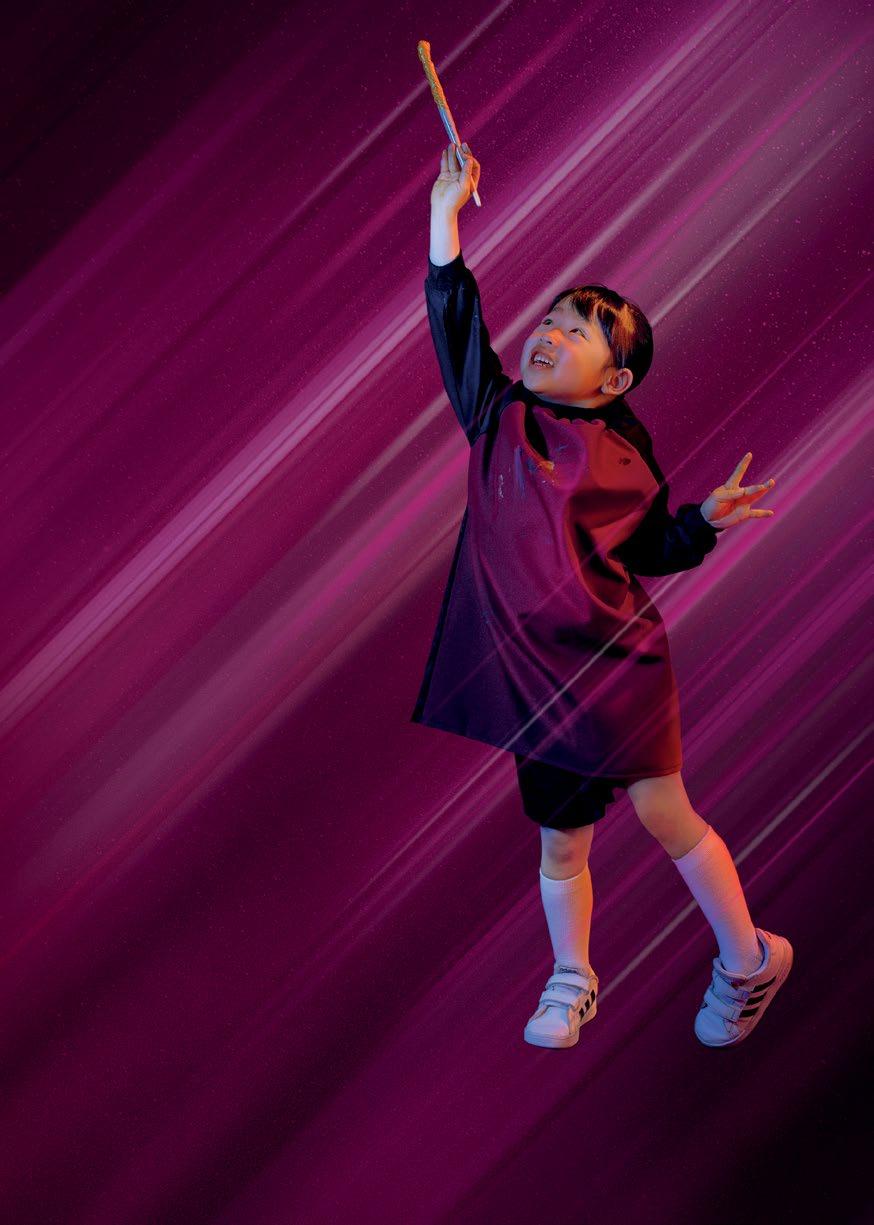
haileybury.com.au
SCHOOL TIME
Well, that was fun, wasn't it! Summer holidays that is... Pplenty of beach visits, several family functions for some milestone birthdays (not mine) which included some overseas cousins I haven't seen all together in 15 years. Grand-dog (as my kids affectionately call my Dad, after Grandad Dog on Peppa Pig!) down from country NSW, a trip to the Grampians (which I'll tell you all about in the Apr/May mag, hello meerkats!) and so much more. Oh, and a nasty bout of Covid just after school finished which got me for about two weeks (so not the best start to Summer).
Speaking of school, my baby girl graduated primary school so I just had to recreate our first day of school pics. I even still had the same top! She's grown a bit, hey? I can't believe it's back to school time already and my baby is in high school. She's even going to the same high school I went to, so it was a super nostalgic week. And so just like that the Summer holidays are over and it's all school, work, sport, repeat. I hope you find some really valuable content in this Education issue of MamaMag. We're all about supporting mamas like you, so if there's ever a topic or something you'd love us to write about, by all means get in touch via my email below. And if you know of any awesome mamas you just know we need to interview (yes, you can say yourself!) I'd love to hear about that too.
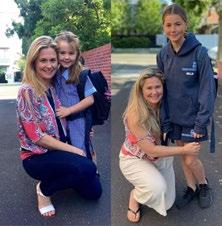
Until next time...
Sarah Cavalier Editor - MamaMag - @thecavaliermama
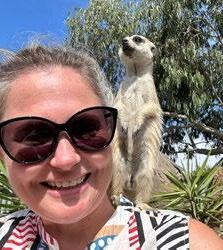

MamaMag is designed and published free online every two months for Melbourne mums, families and carers.
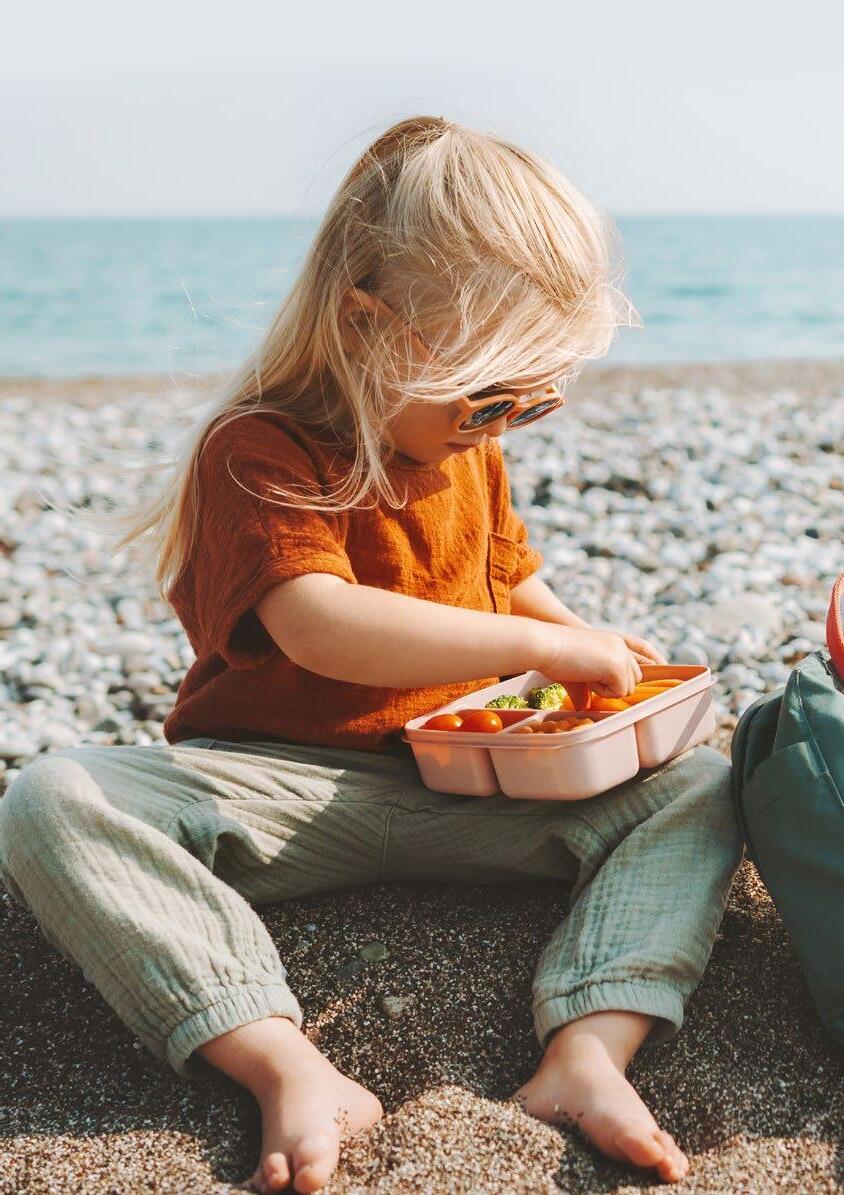
Publisher: Mama Creative Group Pty Ltd. ABN: 26 042 138 550.
PO Box 8018, North Road LPO, Brighton East VIC 3187

Phone: 1300 771 446
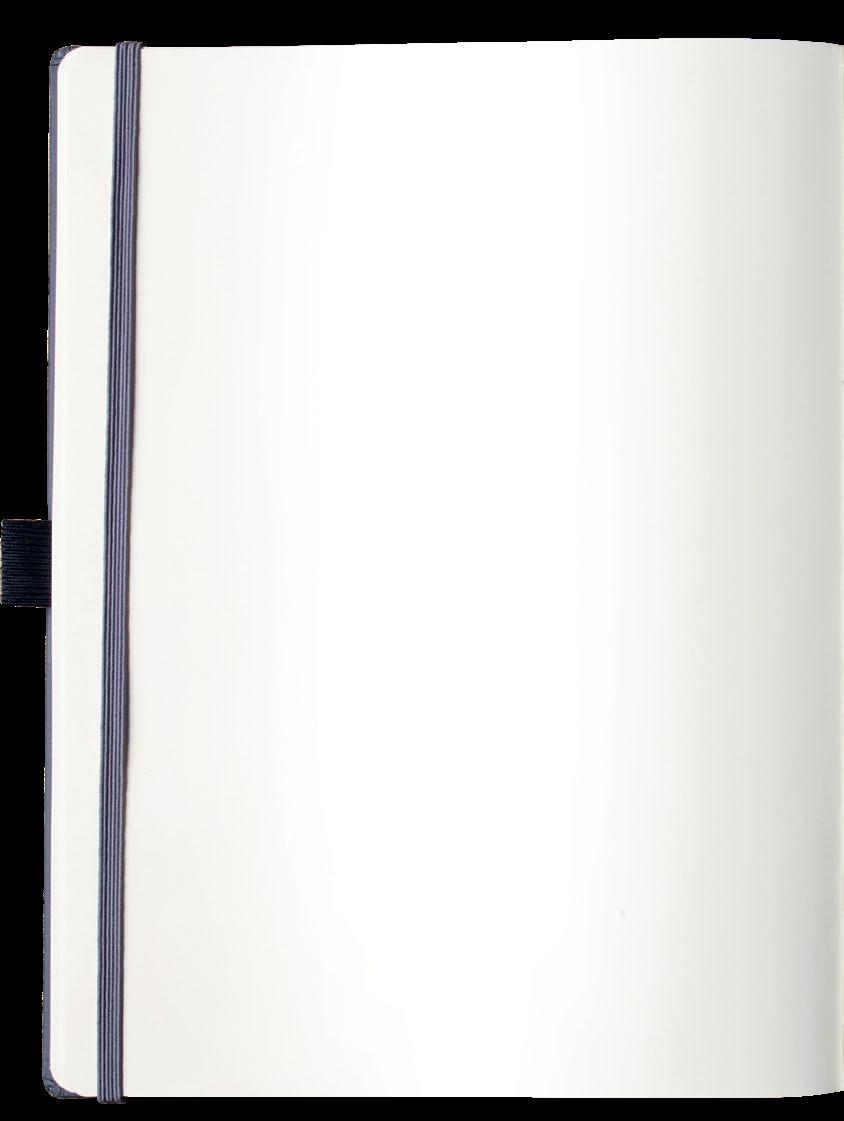
Email: info@mamamag.com.au
www.mamamag.com.au | www.mamacreative.com.au
Editor in Chief/Creative Director: Sarah Cavalier: sarah@mamamag.com.au
For advertising enquiries contact:
advertising@mamamag.com.au
Want to write for us or have an article idea? submissions@mamamag.com.au

Support and fun for the Melbourne mum
Cover image: © NADC/Salty Dingo
MamaMag give thanks to our Supporting Partners.
The opinions expressed herein MamaMag are not necessarily those of the publishing staff. Reproduction in whole or part is prohibited without permission of Mama Creative Group. Health related articles are designed to be informative and educational. They are not intended to provide specific medical advice or replace one-on-one advice from your health practitioner. Some articles contain affiliate links for which MamaMag may be paid a commission when readers shop these links. Shopping affiliate links makes no difference to the price you pay but helps fund MamaMag allowing us to provide our family-friendly resource to you for free.

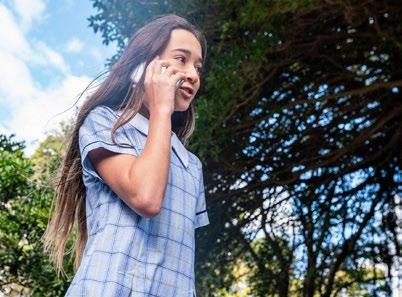



5 MamaMag Feb/Mar 2023 CONTENTS For your chance to win enter at mamamag.com.au/opel Entries are open to Australian residents only. Competition starts February 1st 12.01am and closes March 31st 2023 at 11.59pm. Four winners will each receive 1x Opel Mobile SmartKids Phone. Phone plan or SIM card not included. For more product info: opelmobile.com.au. Visit www.mamamag.com.au/competitions for full entry terms and conditions. Win 1 of 4 Opel Mobile SmartKids Phones WIN Get the kids back to school safely and stay connected with the Opel Mobile SmartKids Phone. In addition to being able to call your child and vice versa, the GPS location tracker will enable you to see where they are at all times. It also has no camera to reduce safety risks and includes a stack of other clever security features such as parental control over downloading apps and screentime, ability to whitelist numbers, an emergency SOS button plus a child-friendly case and screen protector. Worth $249 each. Embracing Taryn 6 Australian of the year Taryn Brumfitt Caring about childcare 8 Where to begin with your search Careers of the future 10 The ones that don't exist yet! Parklife 12 Patchwork Park, Altona North A healthy lunchbox 14 Tips on how to pack the best for your kids Retirement income 16 How much money do you really need Selecting a school 20 Six steps to consider Cyberbullying in schools 22 Your role as a parent First aid in schools 24 First aid knowledge for kids Exceeding expectations 26 Helping your child to thrive Mama can cook 28 Tasty meals from Sophie Guidolin A day at the beach 32 All the essentials you need Magazine boom 34 Bonding with kids over reading Weighing up appetite 36 Healthy habits that stick Free kinder kits 38 Home grown kits for Victorian kids Fantastic ban 40 Victoria bans single use plastics Cycle to school 42 Cancer Council is calling on kids New on the shelf 44 Mama's latest book picks Scream time 48 Getting kids off their screens From nappies to nutrients 50 An industry-leading recycling program Playground squeeze 52 Keeping kids active in small spaces Selective schools 54 Who, what and where?
EMBRACING TARYN
45-year-old Aussie mother of four Taryn Brumfitt is on a mission for meaningful change. Through her award-winning films, best-selling books and international speaking engagements, she has spent the last 10 years empowering people around the world to discover what’s possible when you embrace your life and purpose and she can now add Australian of the Year to her long list of accolades.
Taryn Brumfitt leads the Body Image Movement, an Adelaide-based organisation that teaches people to love and appreciate their bodies and her 10 years of work have led to The Prime Minister, The Hon Anthony Albanese MP, announcing her as the 2023 Australia of the Year.
movement and make the now infamous documentary Embrace to encourage women to be positive about their bodies.
The 2016 documentary tackled the serious issue of women’s body loathing and Taryn’s path to body acceptance. It was seen by millions of people in 190 countries and is today available on Netflix.
Taryn has now written four best-selling books and in September 2022 released another documentary, Embrace Kids, which aims to teach kids aged nine to 14 to move, nourish, respect and appreciate what their bodies can do. Embrace Kids is an uplifting film which brings together a vibrant collection of stories from young people and famous friends alike (Celeste Barber, Erin Phillips, Jameela Jamil), who share their experiences about body image, bullying, gender identity, advocacy, representation and more.
Taryn has also collaborated with body image expert Dr Zali Yager to create an Embrace Kids companion parenting book as well as The Embrace Hub – a free, research-based resource for teachers, parents, children and communities on fostering body positivity.
Not without controversy
The photo that started it all
An unconventional before and after social media post started it all 10 years ago when the above shot went viral due to its 'reverse' nature.
In the "before" photo Taryn stands on stage as a fit body builder. She looks happy, but she later said it was at that moment she realised the hours of daily exercise and restricted eating had indeed not made her happy at all.
The after photo is a much more relateable shot for mamas like us. Cellulite, stretch marks, folds, rolls, all the things, said Taryn.
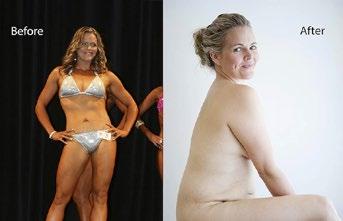
Seeing this response to a post was crazy, that a woman learns to embrace her body, and it becomes headline news in most countries around the world. So Taryn used this global attention to launch her body image
Just hours after Taryn was announced as Australian of the Year, former radio host and journalist Mike Carlton Tweeted that the award should have instead to a doctor or nurse working in an emergency department, not "someone who makes a buck out of saying it's OK to be a bit fat".
He then received a barrage of replies, some agreeing, but many saying body image and eating disorders were big issues in Australia and were worthy of being highlighted by an Australian of the Year.
"Wow. You have clearly never dealt with body image issues that are debilitating for so many. Enormous industries built up on making people feel shit about themselves, destroying themselves in pursuit of an impossible ideal. She speaks truth to a different power."
6
© Kate Ellis
© Andre Agnew
"I take your point about health workers, but eating disorders are a huge and underreported health issue and your take both misrepresents and diminishes Taryn Brunfitt’s work and the importance of what she does, especially for young women."
"You might want to keep an open mind on this one Mike. With research showing children as young as four (boys and girls) expressing negative body image and suicidal ideation rather than feeling empowered and strong in their bodies we have a serious problem. It’s an important issue."

So what's next?
Taryn won't be one to let the naysayers get her down and will now be able to leverage her new-found fame to influence governments to take on her message.
She said she spoke to Prime Minister Anthony Albanese after receiving the award along with several other Commonwealth ministers and has now organised to meet South Australian Premier Peter Malinauskas to talk about her goals — and funding.
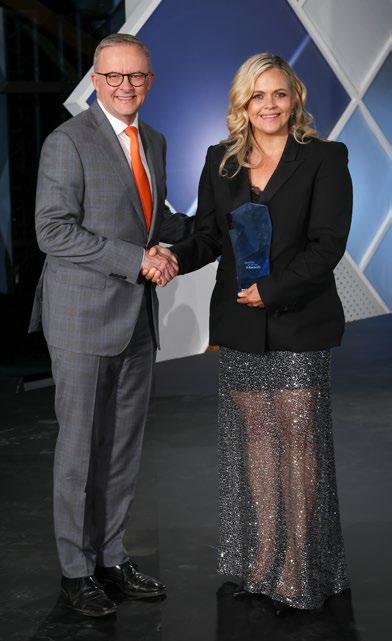
"I've got a meeting with the premier in a couple of weeks and I'm so excited to sit down with him, especially now, and really talk about some funding and some resources," she said.
"I'm such a proud South Australian and I'm very keen to focus on SA and be the global leaders in this space.
"Let's get our kids right and let's show the world what we can do when we embrace our bodies, so yes to resources, yes to money, and then we can get it out free to all schools."
"We really need to help our kids across Australia and the world because the rates of suicide, eating disorders, anxiety, depression, steroid use, all on the increase related to body dissatisfaction."
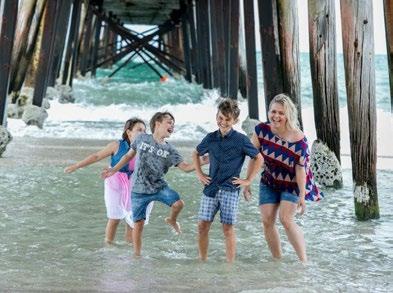

Taryn wants to give children an "armour" to protect themselves from the messages from the diet and cosmetic industry and social media and we can't wait to see where her movement goes.
Find out more at theembracehub.com
© NADC/Salty Dingo
© Meg Hansen Photography
CARING ABOUT CHILDCARE
Raising children raises many questions. None more pertinent than 'where do we begin when it comes to childcare?'
As parents it’s our job to nurture, guide and prepare our children for the world they inhabit.
So, it’s no wonder it feels like one of the most consequential decisions when it comes time to entrust them into the care of others.
At Care for Kids, we believe every child has the right to safe, nurturing and high quality childcare.
We have created the most comprehensive childcare search platform to empower parents in making the best childcare decision for their individual family.
At Care for Kids, we are parents creating what we believe is the ultimate tool to help other families access, understand and connect with the best childcare options in their local area.
We are also on a mission to share with other parents, what many of us here, only understood once our children began childcare. Educators are not merely babysitters. They are our children’s first teachers outside of the home. Their dedication and insights, their care and teachings will impact your child’s early development and your families’ experience of early childhood.
So where do I begin? We hear you asking. Head to careforkids.com.au.
The first step to seeing what’s out there, what fits your budget, location and preferences is at the tip of your finger. Book tours and send your enquiries directly through the site.
Before you go, here are some tips from some of our team on what to consider as you embark on the childcare selection journey.
Ash - “Every child and family has a different version of the right childcare option for them, there are different options out there, so consider what is right for you.”
Kate – “After creating a shortlist of services that might meet their family's needs (using Care for Kids, of course!), I think it's really important for parents to book tours. Most parents will know after a short wander through a service and a chat with the educators if it is a good fit for themselves and their children.”
Georga - “Go with your gut feeling - that’s usually pretty spot on. Do your research, learn all you can, ask all the questions etc but ultimately once you visit the centre and meet the educators, you’ll know if it’s right for you and your family or not.”
James – “ Ask about the learning philosophy of the service”
Jo – “Children are so different, even siblings so when choosing childcare, think about the individual child.”
Don’t forget you have the reviews, detailed descriptions, ability to compare and childcare subsidy calculator amongst other tools on careforkids.com.au to help you make the best decision for this very special journey.
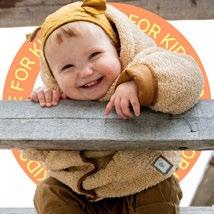
8
FINDING CHILDCARE SIMPLIFIED


See what parents are saying.
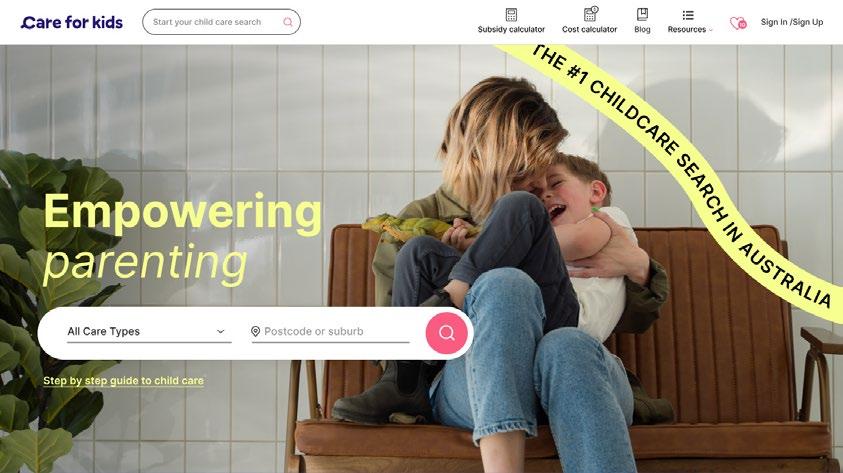
9
CAREERS OF THE FUTURE THAT DON’T EXIST YET!
As the Summer holidays wrap up, the next challenge for mamas across the country starts to appear on the horizon - getting the kids back to school.
While uniforms, stationery and teachers are all strong considerations, it's also important to take a moment to think about the possible end goal for our children's educationa fulfilling career.
A recent report has predicted that in the near future 75% of jobs will require skills in science, technology, engineering and mathematics (STEM) and that 65% of primary school children will end up in careers that don’t even exist yet!

It’s a concern, particularly for our young girls who currently represent only a quarter of students in STEM fields.
To put our minds at ease, an initiative by the Queensland University of Technology called STEM the Tide is helping to bridge this gender gap by shining a bright light on the incredible women already succeeding in these fields,
the pathways available for young girls interested in STEM and encouraging them to take the leap!
It’s well known that the more visible successful women in these industries are and the paths they took to that success, the more young students can see themselves following those pathways.
Women in careers of the future like Tammy Bryant-Butow who has worked as a Chaos Engineer for major international companies like Apple, NAB and Dropbox where she breaks down digital systems to find their weaknesses.
Or Adrianna Eufrosina Bora, who is an Artificial Intelligence (AI) Researcher working with the United Nations to eliminate modern slavery through the application of AI technology.
To help shine an even brighter light down these pathways, we’ve pulled together this list of emerging jobs of the future!
10
AI Ethicist
As AI continues to play a more significant role in our day-to-day lives, issues relating to the legality and ethics surrounding it grow too, indicating a need for advocacy in this field. Prospective students should possess an equal passion for philosophy and robotics alongside an analytic mind.
Self-driving car mechanic
While the role of the ordinary mechanic might become obsolete in future years, even selfdriving cars require maintenance and repair jobs only humans can perform. Picking up advanced software programming and data management skills secures this hands-on job against future redundancy.
Fashion engineer
With climate change now at the forefront of everyone’s mind, the environmental impact of industries is under increasing scrutiny. By combining scientific skills with textiles or fashion, students could map the ecological impact and efficacy of the industry’s practices.
Telesurgeon
As the COVID-19 pandemic becomes less reality and more memory, one practice born out of it — remote healthcare — has stayed put. Naturally, tele-surgeons would combine IT, robotics, and medical skills to operate on patients remotely via a surgical robotic system.
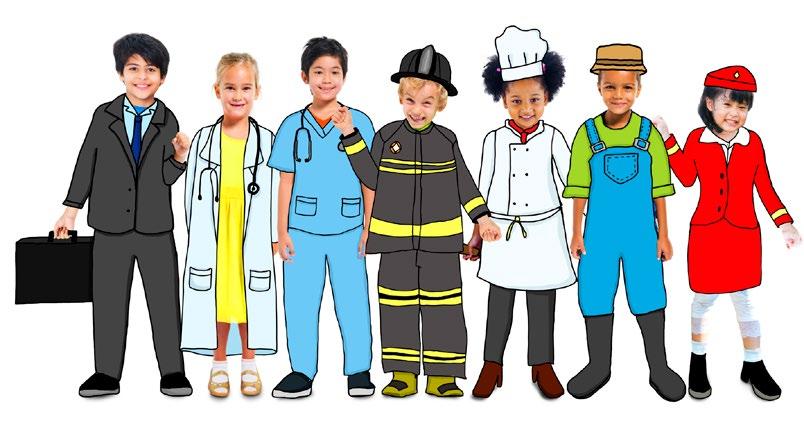
3D printed chef
Remember when the world thought smell-ovision would be the next frontrunner in food technology? While that never happened, 3D printing has advanced significantly over the past few years, making the prospect of whipping up meals via 3D printer very possible. By combining programming and software development skills, math competency, and a love of food, students could become the next big thing in this developing discipline.
Coding ethicist
Human rights activists can future proof their passion by applying their ethical stance to the world of coding. Coding ethicists hold a magnifying glass over companies coding practices, ensuring they adhere to global computing standards of ethics when creating algorithms and tech.
It’s clear that with new career options hatching alongside every technological development, female students are getting ahead of the game by arming themselves with a skillset to stand the test of time.
11
65% of primary school children will end up in careers that don’t even exist yet!
PARKLIFE
Patchwork Park, Altona North
At the heart of Mirvac's The Fabric development in Altona North is the newly opened 4,000 square metre Patchwork Park, complete with spiral slide, climbing structures, musical elements, herb garden and shared barbecues and picnic shelters for residents and the local community to enjoy, large shady trees and green open spaces.
Obviously the highlight is the wonderfully vibrant and colourful spheres that make up the huge climbing structure, complete with connecting rope bridges, several slides and


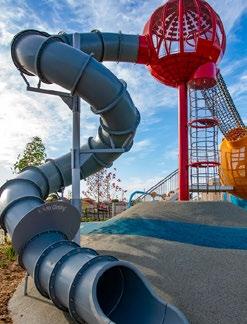
curvy soft-fall floor. But for the little ones there is music play dotted throughout, low lying swings so they can reach the ground and rock climbing stations perched above soft-fall to protect bottoms and heads!
Upon completion The Fabric will be home to circa 1,500 residents across more than 500 two-, three- and four-bedroom townhomes and future mid-rise apartments. So get in quick to explore this fun playground before they all move in!
Corner of Primrose St and Lavender Bvd, Altona North. Enter via 188 Blackshaws Rd.
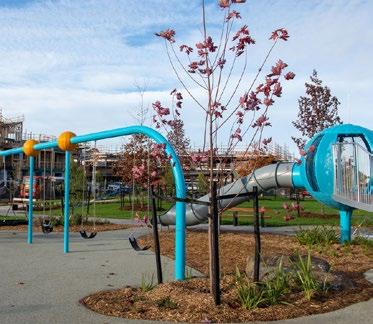
Images © Mirvac
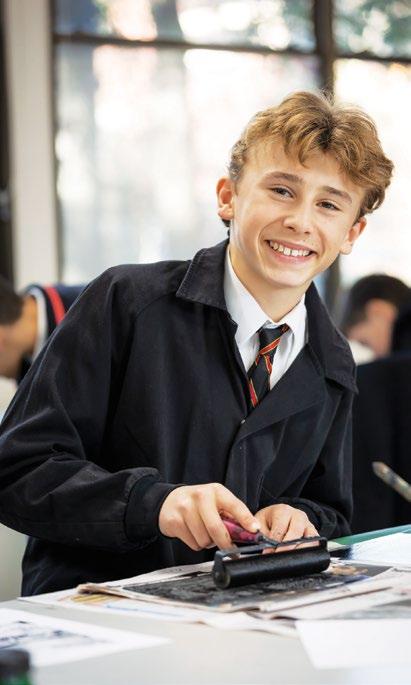
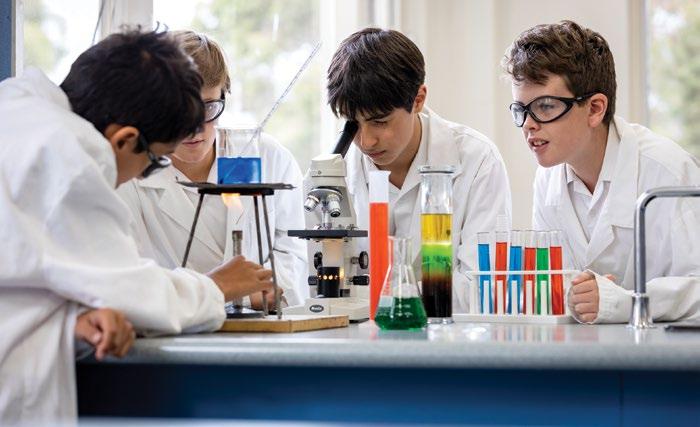


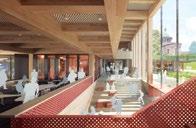

Xavier’s new state-of-the-art Year 7 & 8 building A Xavier education can create the possible Book a tour at xavier.vic.edu.au
HOW TO PACK A HEALTHY LUNCHBOX
Did you know that around 30% of a child’s daily food intake is consumed at school? What your child eats during their school day is critical to their learning and development. Creating a healthy lunchbox may seem daunting however when children eat well, they have more energy and better focus1 Nuzest Nutritionist Lauren Parchi shares her top tips on how to create a healthy and tasty lunchbox for your kids.
1. Build your lunchbox around the three macronutrients
Carbohydrates are the body’s main source of energy, however, not all carbohydrates are created equal. Wholegrain carbohydrates (complex carbs) are high in fibre compared to refined (simple) carbohydrates and promote a steady release of energy (AKA, no sugar rush). Lauren says, “Aim to include one serving of a complex carbohydrate in their lunchbox. Multigrain bread, wholegrain wrap, pasta, seed crackers and brown rice are all good options. Also, there are many high-fibre bread options on the market that look and taste like white bread for the more fussy eater.”
Protein is one of the most important macronutrients in a child’s lunchbox as not only does it promote growth and development, but it also keeps them feeling fuller for longer2. Some good sources of protein include chicken, turkey, tuna, eggs (if permitted by your school), dairy yoghurt, chickpeas, and tofu. These foods also provide other valuable nutrients such as zinc, iron and B vitamins which are necessary to support optimal health and well-being.
Aim to include two servings of protein in their lunchbox. You can achieve this by adding a source of protein to a sandwich or wrap and include a protein-rich snack. Lauren’s
favourite school-friendly high- protein snack is Nuzest’s Strawberry Bliss Balls which are also nut free.
Healthy fats provide a good source of energy as well as essential vitamins and minerals, such as calcium, which is important for building healthy bones3. Aim to include one serve of dairy or non-dairy product. Cheese sticks and yoghurt pots are a great option and if your child is lactose intolerant, unsweetened calcium-fortified non-dairy alternatives such as soymilk and coconut yoghurt are good substitutes.
2. Fruits and vegetables
Fruits and vegetables are a crucial part of your child’s lunchbox as they provide fibre, essential vitamins and minerals, such as vitamin C, zinc and magnesium, which help to promote immunity and vitality. They also provide a source of texture and crunch which is an important sensory stimulant for children. Always aim to include fresh or frozen fruit. Lauren recommends pre-cutting fruits and vegetables so it’s easier to pick up and consume. You can try using cookie cutters to create fun shapes or purchase snack-sized vegetables such as cherry tomatoes, snow peas, baby carrot sticks or mini cucumbers.
3. Prepare ahead of time
Meal preparation and planning is a key tool that can be used to keep you organised throughout the school week. Using leftovers from dinner can be a great way to speed up the lunchbox prep, and getting the kids involved creates some quality time to connect. Simply asking your child what fruit or snacks they would like in their lunchbox can help to ensure they come home with empty lunchboxes.
14
Some other great meal prep hacks include allocating one hour on the weekend to write out lunchbox ideas for the week ahead and batch cooking. Batch cooking is an efficient method that can be used to prepare many meals at once. Pick some of your child’s favourite recipes and double the quantities to increase the number of serves.
Filling nutritional gaps for optimal health
If you still feel that your child’s lunchbox is lacking in nutrition or find you are a constant victim of the ‘uneaten lunchbox’, supplementing with a plant-based powdered multivitamin is a great option to ensure your child is getting the nutrients they may otherwise be missing.

Whilst every child’s lunchbox may look slightly different, it is important not to get caught up in perfection. Listening to your
child’s needs and adjusting the contents to suit, teaches them to be aware of their hunger cues, taste preferences and cravings.
Nuzest Kids Good Stuff is available online and in select health food stores nationally. For more information and recipes visit www.nuzest.com.au
1 Nutrition Australia. (2022). Fact Sheets and Guides. Retrieved from https://www.healthylunchboxweek.org.au/fact- sheets-and-guides. 2 Braun K. V., Erler N. S., Kiefte-de Jong J. C., Jaddoe V. W., van den Hooven E. H., Franco O. H., Voortman T. (2016). Dietary intake of protein in early childhood is associated with growth trajectories between 1 and 9 years of age. The Journal of Nutrition, 146(11), 2361–2367. DOI: 10.3945/jn.116.237164.
3 Weaver C. M., Gordon C. M., Janz K. F., Kalkwarf H. J., Lappe J. M., Lewis R., O’Karma M., Wallace T. C., Zemel B. S. (2016). The National Osteoporosis Foundation’s position statement on peak bone mass development and lifestyle factors: a systematic review and implementation recommendations. Osteoporosis International: A Journal Established as Result of Cooperation between the European Foundation for Osteoporosis and the National Osteoporosis Foundation of the USA, 27(4), 1281–1386. DOI: 10.1007/s00198-015-3440-3
30% of a child’s daily food intake is consumed at school?
HOW MUCH INCOME DO YOU REALLY NEED IN RETIREMENT?

Here’s a wake up call.
The Australian Bureau of Statistics (ABS) reports that more than 75% of retired Australians rely on the age pension for financial survival.
When you consider that the age pension is about a quarter of what an average person in full-time employment earns, mean people face the unpleasant reality of experiencing a permanent fall in living standards once they retire.
If you’re hoping for a better and brighter future than what the majority of Australian retirees experience then it’s crucial that you set a goal to chart a path that mean you avoid having to rely on the age pension for survival. In fact, the act of setting a goal and engaging your mind to figuring out how it could be achieved is the most important step to becoming more financially secure in your retirement years.
Regrettably, a consistently made common mistake is forgetting to set a goal for how much income you want in retirement. It may be because you don’t know how much you
17 Start a Playgroup! Create Something Wonderful Today @playgroupvicofficial 1800 171 882 playgroup.org.au @playgroupvicofficial /playgroupvic 1800 171 882 playgroup.org.au /playgroupvic playgroup.org.au/find/ Playgroup Registration Benefits Include: Insurance Resources Advertising and much more! Start a Playgroup here: www.playgroup.org.au/ start-a-playgroup/
might need, or else what process to follow. The consequence is that you end up earning and spending until retirement looms large, at which time it can be too late to avoid unpleasant consequences. The essential twofold message is this: set an income goal, and set it while time is on your side.
So how much income might you need in retirement? Here are four possibilities:

#1: Rule of thumb
An easy rule to remember is 80 per cent of what you earned before you retired. This assumes that your living standard equals what you used to earn, with the sum but amount scaled back slightly because you won’t have work expenses.
The Australian Bureau of Statistics reports that median weekly earnings for an employed Australian person aged 55-59 employed $85,335 (full time) and $37,142 (part time). 80 per cent would equate to $68,268 and $29,714 respectively.
#2: Retirement standard
The Association of Superannuation Funds of Australia’s (ASFA) Retirement Standard is an often-quoted benchmark. It distinguishes between two living standards: comfortable and modest. Assuming you want to aim for a comfortable level (daily essentials, health insurance, an occasional restaurant meal and an overseas trip once every seven years), ASFA’s suggests you’ll need $45,000 if you’re single (the age pension is $23,000) and $65,000 if you’re a couple (the age pension is $35,000).
What we learn is that the age pension alone won’t provide enough money for you to live a comfortable life (as described and budgeted by the ASFA) in retirement.
#3: Super Consumers Australia
Super Consumers Australia also publish a savings target for singles and couples to support an annual spending at three standards: high, medium and low. If you’re single, aged 57, are planning to retire in 10 years and are aiming for a high standard of living, it is estimated that your annual cost of living will be $54,000, and you’ll need to have saved $742,000. Your savings target becomes the amount of income-earning as-sets you need.
#4: Steve’s Simple Solution
Finally, there is the number I suggest: a nice round $100,000. Yes, it sounds high by the earlier standards, but it you could achieve it then you would almost certainly avoid a dreaded permanent fall in living standards when you retire from the workforce. Remember, the question to ask is not ‘Can I?’, but ‘How can I?’
So what’s your number? Once you have something in mind it will provide a goal to aim for, and a context to guide your investing strategy and individual investments. The alternative is to plod along and hope everything works out. This is dangerous. With more than 75% of retirees reported to be reliant on the pension to survive, the more things you leave to chance, the more chance things will go wrong.
This is an edited extract from Steve McKnight’s Money Magnet: How to Attract and Keep a Fortune that Counts (Wiley $32.95), available at leading retailers.
18



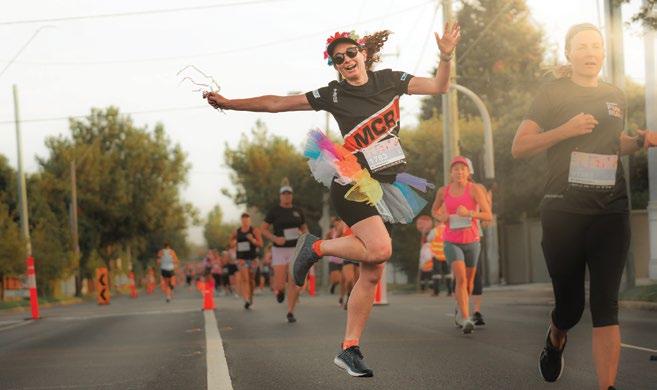

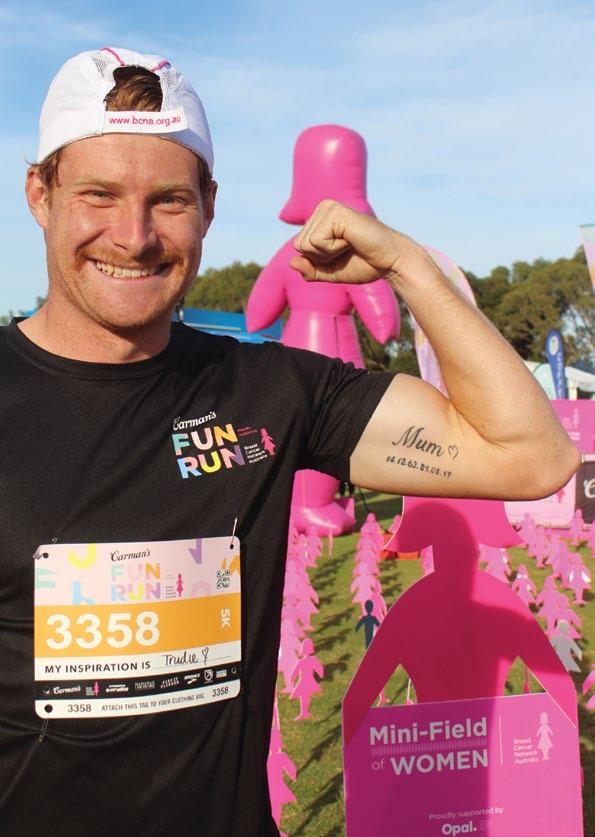



19 FEBRUARY Enter now »»» 2023 carmansfunrun.com.au Elsternwick Park, Brighton 5K, 10K and Half Marathon
Melbourne FC #33 ENTRY INCLUDES: T-SHIRT & MEDAL
Oskar Baker, BCNA ambassador,
SELECTING A SCHOOL
St Leonard’s College Principal, Peter Clague, has travelled the world educating students, meeting countless parents seeking to choose the best school for their child. Here he shares six simple steps for selecting a school.
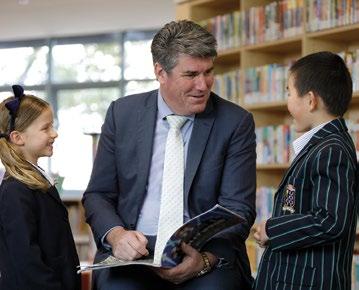
Step 1: Consider your child and family
Having raised four children, my wife and I understand the importance of considering the needs of the wider family. What’s right for one child may differ for another. Selecting a school that offers a smorgasbord of choice when it comes to subjects and cocurricular activities ensures that every child’s unique passions, talents, and interests can be uncovered and nurtured, whilst still embracing a connection with the whole family.
Step 2: Identify your values
Choosing a school that authentically reflects the values you want to instil in your child is fundamental.
It’s important to assess how a school actively demonstrates the character of its students through social action.
If you’re seeking a school that places a high value on community and family, in all its modern adaptations, then selecting a school like St Leonard’s that spans ELC all the way to year 12 is also ideal.
Step 3: Gather information online
When I accepted the role as Principal of St Leonard’s College, I was based in the UK and unable to travel due to the pandemic. Fortunately, I was able to conduct extensive preliminary research online. Like many schools, St Leonard’s offers virtual tours and provides a wide range of information on their website. Following a school’s social media channels also provides a daily peek into the breadth and depth of its daily activities.
Step 4: Talk to the community
The calibre of a school is most evident through positive word of mouth. The willingness of parents and students to share their satisfaction can be a reliable barometer
of quality education. At St Leonard’s College, we often receive feedback from alumni, parents, and even members of the public who have encountered our students. Affirmation about their positive experiences and gratitude for the exceptional teachers and mentors is always an encouraging measure of our success.
Step 5: Visit the school
That said, the best way to really gauge if a school is right for your child is to visit in person. Despite hours trawling the online tours of St Leonard’s College, nothing really prepared me for the impact of the incredible facilities, nor the dynamic culture within them, when I finally set foot on campus. Joining a College tour allows you to observe the culture directly and develop an intuitive feel for whether it is the right fit for your child.
Step 6: Apply
Quality schools that are highly sought after will often have waitlists, so be sure to submit your waitlist application for enrolment earlier rather than later.
Schools with healthy waitlists, like St Leonard’s, often have parents enrolling their children in year 5, a key intake year, as it provides the assurance that their child will then be able to transition directly into secondary school in year 7.
To learn more about St Leonard’s College visit stleonards.vic.edu.au
20

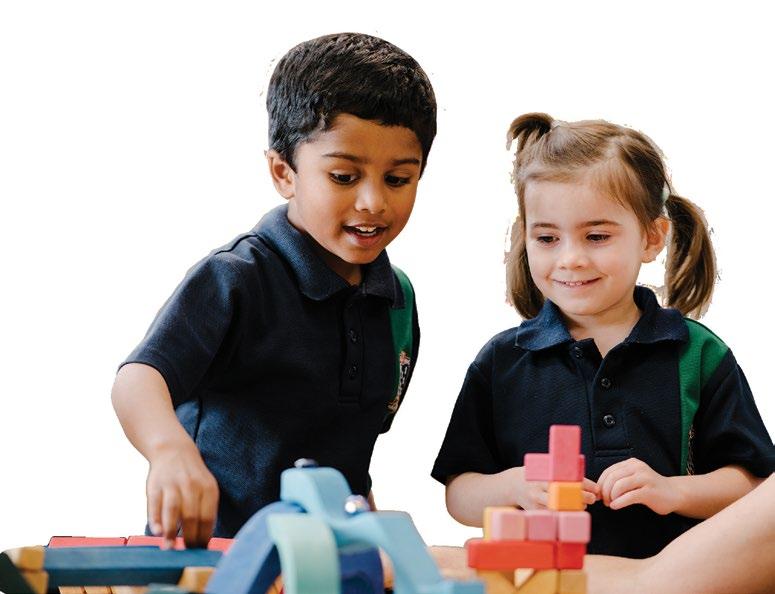

21 Tomorrow’s Innovators doing today? What are Click to learn more
CYBERBULLYING IN SCHOOLS
The dangers of bullying are well documented and despite our best efforts, we don’t appear to be able to eradicate this problem. As both a parent and a psychiatrist, I’ve had the unfortunate experience of witnessing the dire impact of bullying on a child’s mental health. Urgent steps need to be taken to address bullying and to encourage tolerance, respect, and inclusiveness of our differences.
Bullying & establishing cultural tolerance
Bullying and intolerance of differences are problems that have been around for a long time. Adults have been fighting wars and committing senseless acts because of their differences for centuries. White supremacists are no different than terrorists who commit acts in the name of religion. They are both trying to force their beliefs on others and create a world in which everyone is the same. This type of thinking is not only dangerous, but it is unrealistic. People are different for a reason, and we should accept, embrace and celebrate those differences to create a world where everyone is treated respectfully and fairly.
Parents and schools have a responsibility to teach and model tolerance.
Schools can have assemblies or lessons that focus on diversity and how to get along with people who are different from
us. Inviting people of different races and cultural backgrounds to speak and share their experiences of hardship would not only help to raise awareness but also empathy for others.
Parents play an incredibly important role in teaching and modelling tolerance for difference. They should talk with their children about different cultures and religions and emphasise the importance of being kind and respectful. Parents can also help their child to develop empathy by providing them with opportunities to learn about the history of different people and experience how they live.
The government and community can also help to promote tolerance for differences by creating public service announcements or fund programs that teach diversity and acceptance. They can also work to create a society where everyone feels safe and welcome, regardless of their background or beliefs.
Bullying in schools: Is there a fool-proof system in place?
School bullying is a problem that has been around for as long as schools have been in existence. And while there are many different opinions on how to best deal with bullying, one thing is for sure: suspensions and expulsions don't seem to be working.
In fact, according to a study from the University of California, Los Angeles,
22
suspensions and expulsions actually worsen the problem. The study found that students who are suspended or expelled are more likely to drop out of school, and they're also more likely to engage in criminal behaviour. There aren’t easy answers to this problem. Some people believe that we need to create tougher anti-bullying policies, while others think that we need to provide more support for victims of bullying.
Bullied children have higher risks of self-harm, depression and anxiety. The ramifications of bullying are endless and all the more reason to prioritise addressing the issue.

Your role as a parent
As a parent, it can be difficult to keep track of what your child is doing online. But it's important to be aware of their activities, especially if they're young. Here are some tips to help you monitor your child's online behaviour:
1. Talk to your child about the dangers of the internet. Make sure they understand that not everyone they meet online is who they say they are and that there are some people who may try to harm them.
2. Set rules for your child's use of the internet. Establish guidelines for how
much time they can spend online, what websites they can visit, and what type of content is allowed.
3. Use parental controls to restrict your child's access to certain websites or content. Most internet browsers have built-in parental controls that allow you to filter out inappropriate content.
4. Monitor your child's activity. Use a monitoring program or tool to see what websites your child is visiting, what they're talking about with their friends online, and who they're interacting with.
5. Educate yourself about the latest online threats and how to protect your child from them. Stay up-to-date on the latest scams and cyber-bullying tactics so you can warn your child about them.
Bullying and racism can cause tremendous harm to individuals, and they need to be addressed immediately. If you or anyone you know is going through the ordeal of being bullied online or offline, it is crucial to alert someone in authority who can immediately intervene. We must all work together to create a safe and inclusive environment for everyone.
By Dr Lisa Myers, Child and Adolescent Psychiatrist
23
FIRST AID IN SCHOOLS
Parents understand the importance of being able to act swiftly and calmly in First Aid situations, with 98% of Aussie parents, who took part in research by Elastoplast, agreeing that being involved in a previous accident had highlighted the need for basic First Aid knowledge. With children being adventurous, sometimes an adult may not be immediately close by, highlighting the importance for children to have confidence in their own First Aid skills so they feel empowered in their ability to help themselves and each other when needed.
First aid training in schools
A recent study showed that 81% of parents believe children as young as three years old should be able to dial triple zero and ask for help, opening up the conversation around where and when children should be participating in their own First Aid training.
Whilst 50% of parents believe that parents and guardians are responsible for teaching age appropriate First Aid to children, 78% believe First Aid should be taught at schools, with 4-7 years being the age group where more than half (56%) of parents believe this teaching should commence.
To provide a solution, Elastoplast is running its Kids First Aid School Program for its third year in a row, equipping teachers with the knowledge to teach basic first aid in schools, and empower students with the skills they require to keep themselves and each other safe. Developed with ACHPER (The Australian Council for Health, Physical Education and Recreation,) the program is useful for all aspects of life and is curriculum approved, integrating First Aid knowledge into foundational, Year 1 & 2 learning structures.
Dr Sue Whatman, President of ACHPER, states “Schools are places where children are meant to learn and be kept safe. The curriculum is supposed to equip them with life skills that they will carry on outside of the classroom. With this Kids First Aid Program, we are confident that teachers have the necessary resources to teach children these essential life skills that help them keep themselves and others safe, also giving parents peace of mind.”
Parents and first aid training
Children having accidents is a parent’s worst nightmare, so ensuring life-saving knowledge is learnt at a young age will inevitably put Aussies at ease and encourage decisive action and decision making when it matters most. Elastoplast’s mission is to grow the next generation of life savers by providing children with the tools to not only treat minor injuries, but to help them recognise and respond to unsafe situations by either sending for help or knowing who to call in an emergency.
We have identified parents are putting First Aid high on the agenda to learn. The majority of Aussie parents (85%) have attended First Aid training, with over half (54%) having done so within the last two years, and a quarter (23%) within the last 12 months.
While nine in ten (90%) Aussie parents have at least some level of knowledge of First Aid, only 14% say they are confident/ proficient in using it, making the need for refresher training vital in equipping parents to act quickly and calmly in the case of an accident.

24
The most common reasons Aussie parents give for why they have not undertaken any First Aid training include lack of time (41%), not knowing how/where to get trained (40%) and concerns around the cost (29%). As a result, Elastoplast has introduced an engaging and educational age appropriate Kids First Aid school program with practical lessons that will kick-start their children's First Aid learning process. Evidence suggests that learning from a young age can increase the likelihood that children will retain and utilise this knowledge in the future, meaning parents can feel reassured their child will grow up with confidence to be able to respond to emergency situations.
Developed in collaboration with ACHPER, the Elastoplast Kids First Aid Program provides schools across the country with free, curriculum-aligned resources focusing on the key first aid knowledge areas – recognising and responding to unsafe situations, treating minor injuries and sending for help.
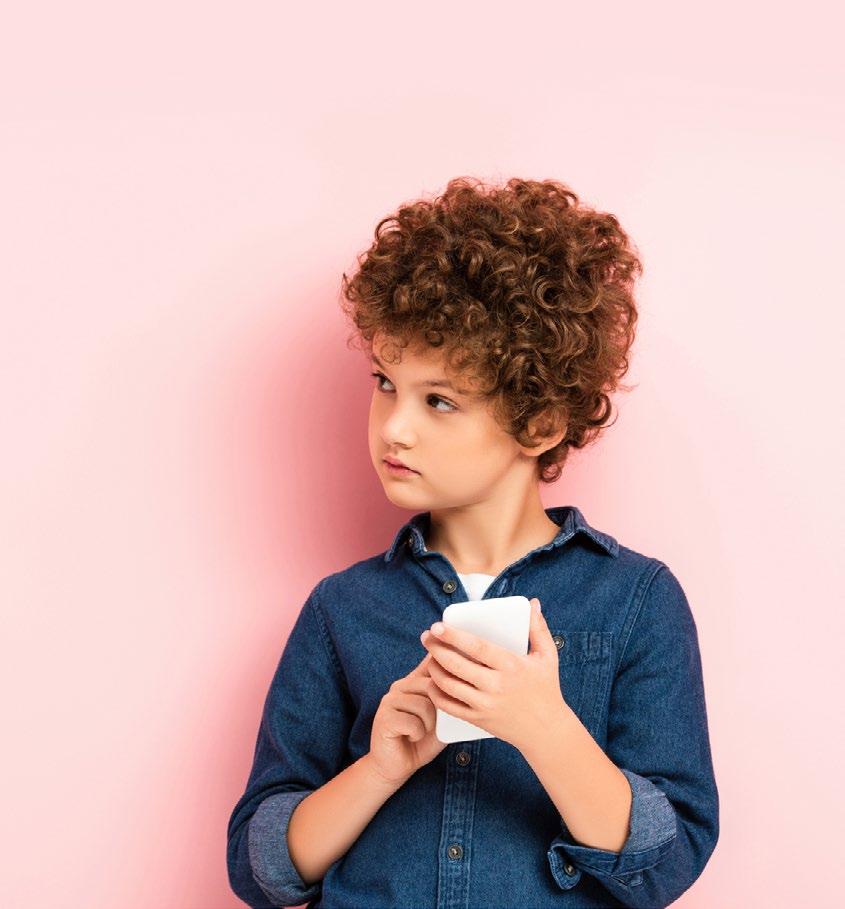
Each school that registers will receive free lesson plans, classroom activity sheets, Elastoplast first aid product samples and even a pack of 1st First Aid Certificates to hand out to students when they have completed the program.
If you'd like your school to get involved direct them to www.elastoplast.com.au/pages/kidsfirst-aid-program for more information and registration
25
81% of parents believe children as young as three years old should be able to dial triple zero
EXCEEDING EXPECTATIONS
...and helping your child thrive.
Every parent should take great care in choosing the right early education for their child, seeking to determine which environment will support them and allow them to reach their full potential. It can be difficult to work out what is best, so to help you decide whether St Michael’s Grammar School is the right for your child, let's learn a little more...
Last year St Michael’s Early Learning Centre (ELC) was assessed by the Australian Children’s Education and Care Quality Authority and given an Exceeding rating meaning the ELC goes above and beyond what is expected, and its programs demonstrate excellence and innovation.
The 3YO Kindergarten and Pre-Prep programs, influenced by the Reggio Emilia Education Project and guided by the Early Learning Years Framework, are the beginning of a continuous learning journey, taking a child right through to Year 12.
The ELC offers a full-time program together with a Before and After School Care and a Holiday Program, all staffed by qualified Early Childhood staff and approved for the Child Care Subsidy.
Children attending the ELC have specialist classes in P.E. and Movement, Music, Art, Literature and Research and, for Pre-Prep children, Mandarin. Importantly these classes are taught by Junior School specialists, so the children can build positive, trusting and respectful relationships with resident experts. This supports a smooth and positive transition to Prep and beyond.
The spaces within the ELC have been designed to maximise flexibility and opportunities for exploration. There are
spaces for quiet contemplation, collaborative work, self-directed learning and larger group experiences.
There are also two designated external play spaces for each year level group. Three-yearold children are invited and encouraged to explore the outdoors, which include interchangeable obstacles courses that develop, extend and challenge their social and physical skills. Pre-Prep children have an outdoor decked area that facilities indoor/ outdoor learning, and additionally, they are challenged to be responsible risk-takers and creative problem solvers within their purposebuilt playground area and mud kitchen.
The children also have access to the broader school facilities. Children regularly visit the school's kitchen garden providing them with the experience of observing and documenting the growth of the various plants, herbs and chickens. It is a wonderful, hands-on learning area.
The children have various opportunities to be involved in the wider school community through House sporting events, the Gipson Commons where our Knowledge Commons, or Library, is located, Community Action days and School celebrations providing ELC children with a strong sense of belonging. Every child is allocated a House and the House system guides students right through school life and is the focal point for a supportive, inclusive and encouraging culture.
St Michael’s believes that each child is unique and should be celebrated. The School values inclusivity and diversity with respect for culture, faith, gender and ability. It teaches children ‘how to learn’, inspiring their curiosity, as they develop resilience, confidence and their agency.
26

Agency that empowers them. We support our students to be confident forthright individuals who are independent ethical thinkers. APPLY NOW stmichaels.vic.edu.au Co-educational | K–12 | St Kilda | 8530 3310
MAMA CAN COOK
Spinach Tortilla Wrap

Serves 2. Dairy free, gluten free option
Ingredients:
1 large (51g) egg
1 cup packed (35g) spinach
1 tbsp (10g) spelt flour
Light spray oil
80g grilled chicken breast
30g avocado
¼ cup (22g) grated carrot
¼ cup (25g) grated beetroot
Method:
Blend spinach, egg and flour in a blender or Nutribullet until smooth.
Heat a non-stick pan on medium. Lightly spray with oil.
spinach mixture in and tilt
pan in a circular motion to spread mixture out thinly like a crepe. Cook until almost set. Flip and cook for a further minute.
Transfer wrap to a plate and allow to cool.
Top with avocado, chicken, and salad. Wrap up and enjoy!
An awesome lunchbox inclusion for both the kids or for work. An alternative to spelt flour is plain flour or for gluten free, use a gluten free plain flour or buckwheat flour.
Tip: Sweet potato noodles can be found in the Asian aisle of supermarkets. Alternatively use brown rice vermicelli noodles for the same macros.
Vietnamese prawn noodle salad

Serves 2. Gluten & dairy free
Ingredients:
250g medium or king prawns
1 clove garlic, finely diced
1 tsp coconut oil
80g sweet potato noodles (dry)
1.5 cups bean shoots
½ medium red capsicum, 12 snow peas
¼ large cucumber
½ medium carrot
1 spring onion
¼ cup min
¼ cup coriander
1 tbsp roasted peanuts
Dressing:
1 clove garlic, finely diced
¼ tsp red chilli, finely diced
2 tbsp fish sauce
2 tbsp rice wine vinegar
1 tbsp coconut sugar
1 tsp tamari
Method:
Chop capsicum, snow peas, cucumber and carrot into matchsticks. Slice spring onion, chop mint and coriander, and set aside.
Combine dressing ingredients – finely diced garlic and chilli,
fish sauce, rice wine vinegar, coconut sugar and tamari.
Boil a saucepan of water and cook noodles for 8 minutes (or as per packet instructions). Drain water and cool.
Heat oil in a non-stick frypan. Add prawns and garlic. Stir fry for 6-8 minutes until cooked through.
Divide noodles, vegetables, herbs and prawns between two bowls. Pour dressing over and toss to combine. Top with spring onion and peanuts.
29
Sophie Guidolin is a published author, fitness model, qualified trainer, nutritionist and wellness advocate. Find more of her tasty ideas and treats at sophieguidolin.com.au

Monster Muesli Trifles

Prep time: 20min | Serves: 5
Ingredients:
1 medium mango
250g strawberries, quartered
2 cups Greek-style or coconut yoghurt
Monster Muesli:
2 cups rolled oats
1⁄2 cup sultanas
1⁄4 cup dried cranberries
1⁄4 cup pepitas
1⁄2 cup shredded coconut
1 tbsp ground cinnamon
1 teaspoon ground nutmeg
1⁄4 cup black chia seeds
Method:
Make the Monster Muesli: Place all ingredients in a medium airtight container; mix together with your hands. This amount of muesli serves 8; you only need 1 cup for this recipe. Seal the remainder in the container and store at room temperature for up to one month.
Cut cheeks from mango; scoop the flesh from cheeks and chop coarsely. Combine mango and strawberries in a small bowl.
Divide fruit among four 375ml glasses. Top with yoghurt, then 1⁄4 cup of the Monster Muesli on each serve.
30
SAT 18 MAR - ESSENDON
SUN 19 MAR - ROWVILLE

MON 20 MAR - HOPPERS CROSSING
TUE 21 MAR - MORNINGTON
WED 22 MAR - ELTHAM
FRI 24 MAR - SOUTH MORANG
SAT 25 MAR - WARRAGUL
SUN 26 MAR - BOX HILL
FRI 14 APR - BACCHUS MARSH
SAT 15 APR - BELL POST HILL
SUN 16 APR - MT HELEN
MON 17 APR - STRATHDALE
TUE 18 APR - SHEPPARTON
WED 19 APR - ALBURY
FRI 21 APR - CLAYTON
SAT 22 APR - WILLIAMSTOWN
SUN 23 APR - RINGWOOD
SAT 6 MAY - CRANBOURNE EAST
SUN 7 MAY - CAULFIELD
31
SALE - BOOK NOW www.kidspromotions.com.au/whatson
VICTORIAN TOUR ON
A DAY AT THE BEACH
As the sun continues to shine this summer, a family day at the beach is a must! Most Aussies have had a long-standing love affair with the beach. We have our own wonderful memories of days out exploring rock pools, swimming and playing in the sand and want our kids to enjoy the same memories.
What we don’t remember is the mountain of ‘stuff’ our parents had to pack to make the day survivable! Here’s a beach-packing checklist from Shae Rickards, Global Nutrition Manager and Paediatric Dietitian at Bellamy’s Organic to help you get prepared.

Sunscreen and rash guard

Make sure you apply sunscreen to your toddler (and yourself) before you put any swimmers and clothes on. The ideal time to do this is at least 20 minutes before you leave the house and well before you are out in the elements. Make sure your sunscreen is at least 30 SPF, broad-spectrum and water resistant. It will need to be reapplied after swimming. A rash guard is also a great idea. It helps cover more of your toddler’s delicate skin and allow you to use less sunscreen.
Hat and sunnies

Make sure you all wear a wide brimmed hat that covers your ears and neck. For your little one, consider an under-chin strap, otherwise their hat will most likely end up in the water. Sunnies are also a must to protect your kids’ precious peepers. For toddlers, a strap is also a good idea, for the above reason!
Brolly or beach tent
An umbrella or beach tent is a good idea for a day at the beach. Not only does it provide shade, but it keeps you dry too. Bring shade that fits over your entire body to make sure you receive maximum protection from the sun (and hopefully not the rain). Finding a tree is always a great idea… if you can find one.
Snacks
Shae says no day at the beach is complete without a cooler packed with all your favourite snacks. Sand is always the enemy when it comes to food at the beach, so be sure to include ingredients that are packaged ready to eat, or pre-cut, to reduce handling.
Great snacks for your toddler include:
• Bite-sized soft pieces of fruit like watermelon and strawberries
• Grapes - cut in half (you can also freeze these the night before)
• Natural yoghurt
• Bellamy’s Organic Pear & Apple Snacks
• Bellamy’s Organic Banana & Strawberry Hearts
• Bellamy’s Organic Milk Rusks for your teething toddlers
• Wraps or sandwiches - (we love a vegemite sanga that doesn't melt in the heat!)
• Soft veggie pieces like cherry tomatoes (cut in half), sliced cucumber and capsicum
• Ice packs - to keep everything cool. If you don’t have ice packs, try using a frozen water bottle to keep food chilled and safe.
Some of these foods are perfect for the big kids too!
Shae says that with some delicious fruit, ready to go Bellamy’s snacks and healthy sangas on hand, you will hopefully have more chances of resisting the smells of takeaway chipswith-vinegar!
Hydration
Shae also stresses the importance of water. Staying hydrated during the day is important and having plenty of cool, tap water on hand will help stop you from purchasing sugary drinks.
32
Be sure to take a refillable cup or water bottle for each person. Pre-freezing some water bottles in advance is also a great idea and can be popped into the cooler in place of ice.

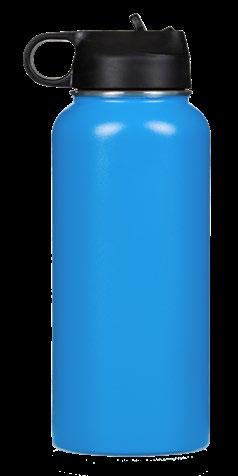
If your little one is still nursing, a nursing cover can come in handy, protecting your little one from the sun.
Toys
Toys can help keep your toddler busy while you relax a little. These include a big bucket and shovel, a plastic boat and toy cars or dolls. If you’re taking some older kids as well, a beach cricket set and boogie board are always popular.
Bags and clothes
Take a sturdy, waterproof beach bag to carry all your belongings. The bigger the better. Pack a garbage bag for any rubbish, as well as an additional waterproof bag that you can put wet clothes in. A mesh bag is handy for holding toys and a waterproof phone pouch is helpful for keeping your phone clean and dry.
And don’t forget to take a change of clothes for your toddler and yourself!
Chairs and towels
Beach towels, a large blanket and beach chairs all make life more comfortable during your day out. You can even get tiny beach chairs for your toddler. A sarong always finds multiple uses, the primary being draping it over yourself when you’re napping.

Wipes and sanitiser
With sand ready to stick to every surface and sneak into every crevice, fragrance-free wipes always come in handy at the beach. They help clean sticky fingers and remove sand from faces. And of course, we’re now old hands at taking the sanitiser whenever we head out!


Shae Rickards is the Global Nutrition Manager at Bellamy’s Organic. Shae has a particular interest in early childhood nutrition and is passionate about ensuring children have the best start to a lifetime of eating.
She is actively involved in several nutrition committees including the Dietitian’s Association of Australia Paediatric Leadership Team, Breastfeeding group, Food Allergy and Intolerance Leadership Team and The Department of Health Early Childhood Reference Group.
Find the full range of great Bellamy's Organic snacks here.

33
MAGAZINE BOOM
Parents and grandparents are bonding with children over favourite stories and magazines.
Parents and grandparents are introducing children to a variety of comic book genres and reading materials as a way of instilling a lifelong passion for reading.
Research commissioned by all-you-can-read subscription app Readly and conducted by YouGov shows almost 3 in 4 Australian parents and grandparents believe their consumption of comics and fantasy magazines as children was instrumental to firing up their interest in reading, and they’re passing the habit on to their children and grandchildren.

43% of parents and grandparents have shared a comic or fantasy magazine with children in the belief that reading “improves language skills”, “enables children to learn more about various subjects or cultures”, and “gives children time for themselves”.
When it comes to favourite genres to introduce to children, superhero comics were the top choice for 58% of respondents, followed by fantasy (49%), classic Disney (49%) and comedy (46%). Surprise genres also included Manga (28%), non fiction (27%) and horror (22%). Parents and grandparents believed comics and fantasy magazines were ideal for developing a habit and love of reading – such materials were accessible to children of all reading levels and the genre was good for sparking young imaginations.
Readly’s recent collaboration with Disney to launch 80+ Disney magazine titles to its children’s category is a timely event, adding scores of characters from familiar and muchadored films and shows to its repertoire like Mickey Mouse, Donald Duck, Frozen, High School Musical, Star WarsTM, MARVEL and more to entice young readers into the world of reading.
Older parents and grandparents in particular showed a soft spot for the superhero and classic Disney categories with 79% of respondents aged 50-59 eager to impart their fondness for cherished superhero characters and 73% of respondents aged 60+ keen to pass on comics that included their most loved classic Disney characters. Though they similarly favoured superhero comics, fantasy and classic Disney content, 45% and 36% of parents aged 40-49 also choose to introduce children to Manga and horror titles respectively.
Though many kids (39%) still read physical books, 21% mostly read digital formats while a further 34% read both formats in equal measure. Most kids read on a frequent basis with almost 1 in 4 kids (24%) reading digital materials every day and 29% of kids reading digital formats several times a week.
Generations of parents have enjoyed introducing kids to their personal childhood reading staples from classic children's titles to their favourite Spiderman comics. Reading together and engaging with children through shared interests is an effective way to inspire a lifelong love of reading and our latest Disney additions will give parents and children even more content to choose from.
Not only are quality comics and magazines enjoyable, they’re accessible to all levels of readers, making them the perfect gateway into reading more often and more widely. Readly is constantly expanding its vast collection to include it all from well-known classics to the latest action-packed comics. We’re thrilled to be able to offer our subscribers instant access to the entire collection at the touch of a button so they can help more young readers explore new genres and titles.
Chris Couchman, Head of Content at Readly.
34
Where young imaginations soar.
Providing your child with the best start to their educational journey.
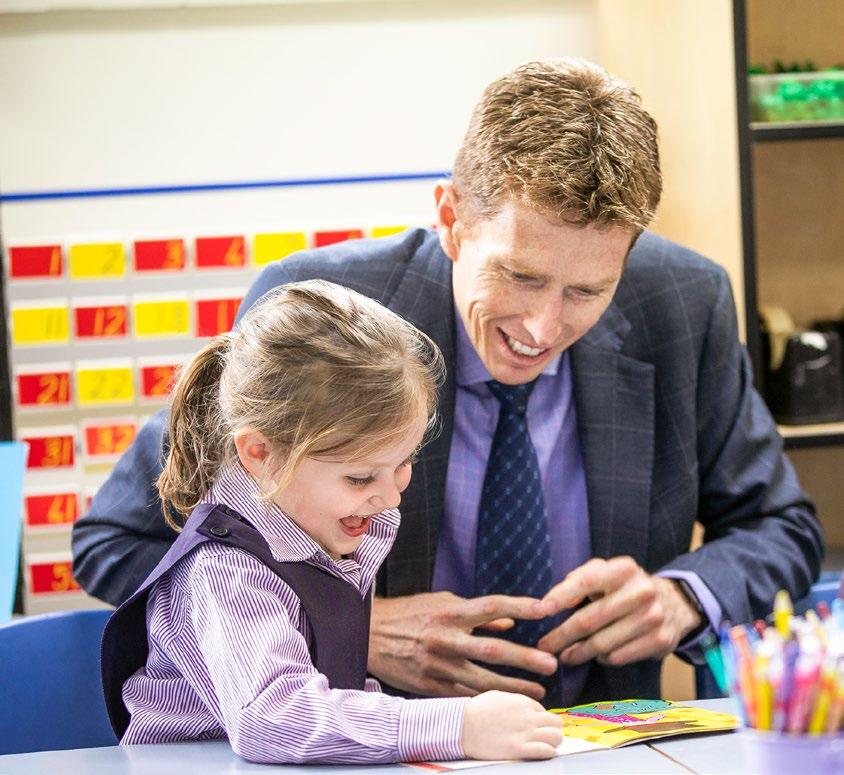
• High teacher-to-student ratios
• Purpose-built learning spaces
• Chinese language program
• Specialist offerings in Visual Arts, Dance, Drama, Music and Physical Education
Book a tour at one of our three campuses or attend
Elsternwick Campus Open Day
Saturday 4 March at 9.30am
• Strong focus on student wellbeing
• Leading VCE and IB World School
• All Early Childhood Learning Centres at Wesley College awarded the highest rating of ‘Exceeding’ by ACECQA
Elsternwick | Glen Waverley | St Kilda Road
WEIGHING UP APPETITE
Remember being taught to finish everything on your plate?
This advice teaches children to ignore natural hunger and appetite cues. Teach your children to tune into their hunger. Explain that hunger is a way of telling us when we are ready to eat and fullness is our body’s smart way of telling us it’s time to stop eating.
If they aren’t hungry, don’t force them. If they want food, ask them if they are hungry or bored or tired or something else? If they are hungry, let them fill up on as much healthy, everyday foods until they feel full, while not restricting them from less healthy options either.
It might mean one day they graze on next to nothing and the next eat for the world, but our appetite is the key to feeling normal around food. Your appetite’s purpose is to provide energy for your body, which is unique and different from others.
I quite like the phrase, ‘Oh, you’re having a hungry day’ when I’m speaking to my son, said in a neutral tone. It feels like I’m helping him to understand that some days he will naturally be more hungry, and other days, less hungry. The tone really matters, and so does the age of your child. The opposite, ‘It seems you’re just not as hungry today’, comes along with it so that there is balance showing the natural ebb and flow of appetite during growth spurts, teething, busy daycare or school days and whatever else.
However, I can see how saying, ‘Oh, you’re having a hungry day’ to a tween or teenager is going to hit them quite differently! Sounds confusing? That’s a fair assessment. As children become more aware that thin is the idealised body state, accusations that they are eating too much or too hungry (no matter how you phrase it) may teach them that there is something wrong with their appetite.
Just one more bite!
Dinner time with kids. You used at least three different vegies (hello colour!), dressed them up with some delicious cheesy sauce and are about to start your own home-cooking channel, you’re so pleased with yourself. That’s until your kids turn their nose up at what you’ve served. What is this rainbow dinner when all they want is a beige buffet? Frustration sets in. You believed this was one meal your kids would enjoy. Why did you waste your time– and food? But while it’s tempting to start a dinner-table power struggle, threatening that they must eat it or at least have one more bite, it’s not a good idea.
‘Please. Just have one more bite’ is a plea uttered by many desperate parents at meal time.
As a parent of a toddler, I understand it’s easy to feel worried when your child isn’t eating well or concerned they’ll go to bed hungry. So what harm is asking them to have just ‘one more bite’ when it’s encouraging more variety in their diet?
As parents, we just want what’s best for our kids– and with 95 per cent of Australian children not getting the recommended amount of vegetables a day, it’s easy to fear they’re not filling up on the healthy stuff.16 The big problem with the ‘one bite’ rule is that it’s a rule, and associating rules with food is never healthy. It moralises food and can lead to guilt and shame. Encouraging a child to eat more or less than their appetite says they need can disrupt their internal feelings of hunger and fullness. It’s a big problem we see today with so many of us eating by the clock, or a meal plan, rather than by appetite.
Bottom line is that the eating habits you start as a kid go with you into adulthood. Creating pressure around food can lead to children ignoring their natural cues. Of course, we need to remember kids have very little control in their lives. Where they go, what they wear, what they are going to eat is largely
36
determined by us, so they often flex their independence in terms of what options they choose to eat.
Strategies to encourage picky eaters
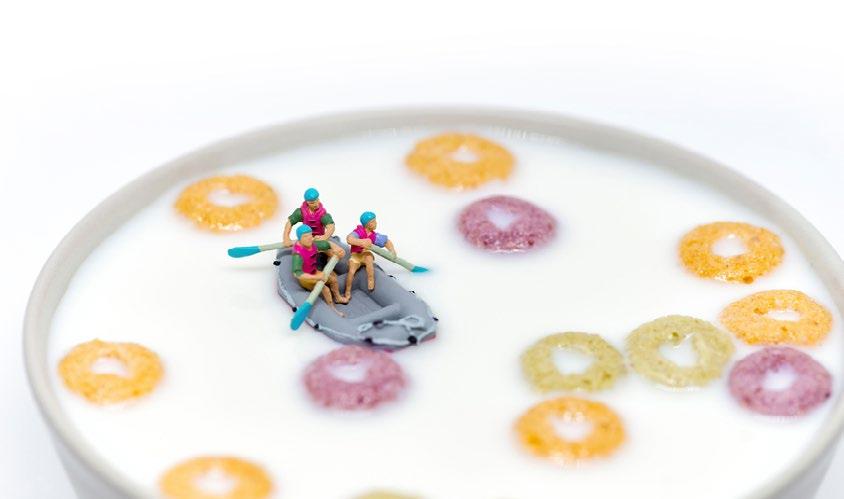
Ask yourself, would I actually eat this? When it comes to kids we can sometimes go too purist or ‘clean’ with food. Plain can also mean devoid of flavour and fun. If what you’re serving your child seems unappetising even to you, then it’s time to rejig your thinking and try out some different recipes. Shameless plug: finding new, kid-friendly recipes doesn’t have to be tricky. My app Back to Basics is designed for busy parents and people who just want a yummy, easy and healthy dinner sorted.
Play dress-ups. This isn’t about adding sugars and salts, but adding flavour to food. Olive oil and cheese are two versatile options, while I like to add peanut butter to broccoli so it’s not so sad and doubles as an allergen exposure.
Try up to ten times. We want our kids to eat variety, so while it’s easy to feel despondent, don’t give up. Research shows children often need at least ten times of seeing a new food before they’ll even try it, whereas we as parents tend to give up after three to five exposures. Given the effort and waste– it’s understandable– but persevere if you can. Simply place the food on your child’s plate (a small amount to start). Even if they don’t touch it, this small interaction with the food counts as an exposure.
Combine with familiar foods. Introduce a novel food along with a food they already accept. If pasta is much loved but zucchini isn’t in favour just yet, use a peeler to create zucchini ribbons. Or add zucchini to some pasta sauce. Or try grating just a touch on top.
Role model. Sit with your child and eat bits of the same food you served to them. It’s not about tricking them, but showing you enjoy carrots too. And if you don’t? Find another healthy option you do enjoy.
Batch cook and freeze. Use ice-cube trays to make small portion sizes so you can continue exposing new foods to your kids without huge waste. This also gives you the option to keep changing things up and present new food without making it the whole meal. By giving small amounts, kids still have their familiar favourites, while not getting overwhelmed by the unknown.
The way you speak to your child now will inform how they will eventually speak to themselves. You’re helping to shape their own inner critic, to hopefully be, well, a lot less critical. A gift every kid deserves to unwrap. An inner voice that speaks kindly and gently.
Text from Your Weight is Not the Problem by Lyndi Cohen. Murdoch Books RRP $32.99.
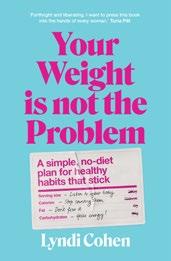
FREE KINDER KITS
Victorian children will receive a free Kinder Kit full of fun and educational toys, books and resources when they start Three-YearOld Kindergarten, helping them to grow and thrive through creativity and play as part of the Andrews Labor Government’s ambitious reform of the state’s early childhood system.
The kits are designed to encourage continued learning through play at home and include lots of tips and ideas to help parents guide their child’s early learning and development.
The illustrated Kinder Kit carrycase is made from recycled materials – designed and built for flexible, long-term use. The case opens out to become a play surface with whiteboard and markers and can be repurposed as a memento box for each child.

The kit includes Tinta Crayons, Tiger Tribe whiteboard markers and castanets, Wild Dough playdough, a Micador early start development activity pad, Seed Collection alfalfa seeds, Flip Make Play family playing cards and Purebaby story cubes designed by Nikita Rotumah, a Traditional Owner and proud Gunditjmara Bunitj woman.
Children will also receive two great Australian books from a list including Birds In The Bush by Aunty Fay Stewart- Muir and Jeannette Rowe; Whose Animals? Australia, by Jeannette Rowe in consultation with Aunty Fay Stewart- Muir; Where is Galah? by Sally Morgan and My Friend Fred, written by Frances Watts and illustrated by A. Yi.
Each item in the kit is age-appropriate, child-safe and inclusive, and has been recommended by education experts to help families make “learning through play” part of their child’s everyday life.
All Kinder Kit suppliers are Australian businesses, with an estimated 60 Victorian businesses, creative talent and makers proudly represented in the kit’s design and items.
Through the Best Start, Best Life reform, the Labor Government is delivering an ambitious overhaul of early childhood education over the next decade to help children thrive, save families money and support parents, especially women, to return to work.
“All children deserve the best start to life – two years of free, quality early childhood education gives our children a strong foundation for success at school and supports their learning, development and wellbeing.”
Minister for Early
Childhood
and Pre-Prep Ingrid Stitt
Kinder Kits are a great way to get families directly involved in their child’s education and the value of play-based learning. We can’t wait to see how children and families make these kits their own.
38
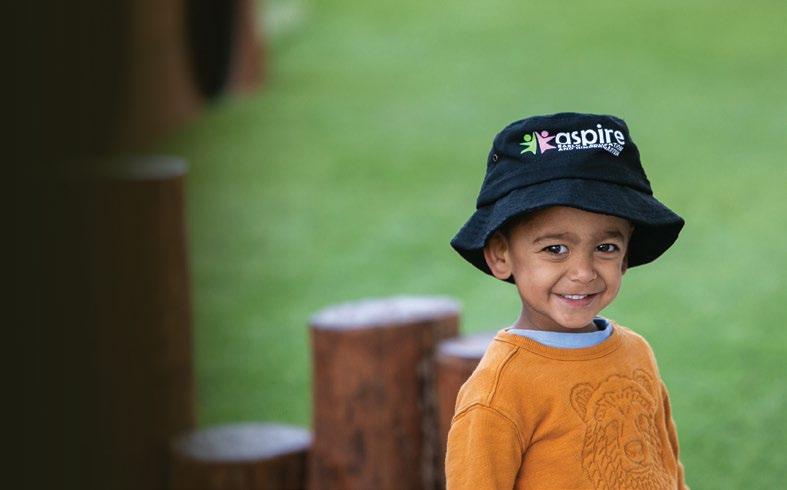
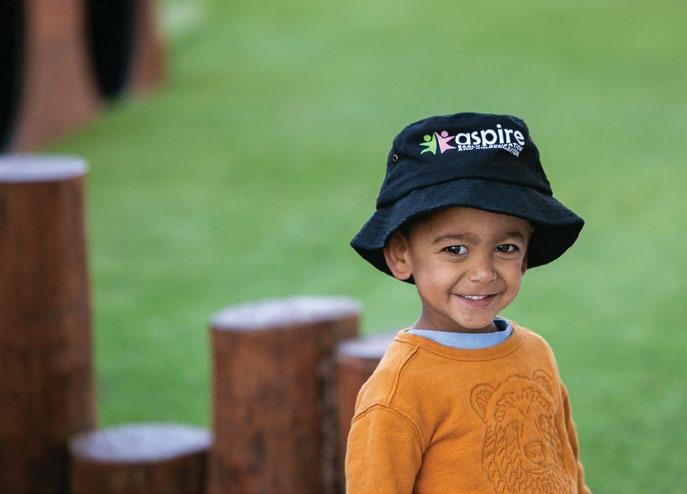

Get more from mama - www.mamamag.com.au | Get social with mama - @localmamamag 39 Enquire Now: 1800 978 429 | www.aspirearlyeducation.vic.edu.au Long Day Care Qualified and Passionate Educators Funded 3-&-4-Year-Old Kindergarten All Inclusive Service Nutritious Meals Nappies Sheets Music Programs Sunscreen Sports & Yoga Lessons ✓ ✓ ✓ ✓ ✓ ✓ ENROL NOW Primary: Years 5 - 6 Secondary: Years 7 - 12 www.delasalle.vic.edu.au 1318 HIGH STREET MALVERN VIC 3144 PH 03 9508 2100
PLASTIC BE GONE
Single-use plastics make up a third of the litter in our streets and waterways. They remain in the environment for a long time, harming our wildlife and contaminating our food and water.
The Victorian Government has received thousands of responses from local businesses, community organisations and customers supporting bans on single-use plastics, so from 1 February 2023, problematic single-use plastics will be banned from sale or supply in Victoria.
Who does the ban apply to?
The ban applies to all business and organisations. Key sectors include:
• Retail and hospitality businesses, such as cafes, bars, restaurants, hotels, takeaway food outlets, party stores, discount stores, supermarkets, market stalls, festivals, events, and online stores.
• Suppliers, such as manufacturers, distributors, importers, wholesalers, and online marketplaces.
• Organisations and non-for-profits, such as health and community services, charities, community groups, sporting clubs, schools, and government bodies.
The ban does not apply to individuals undertaking private or domestic activities using existing plastic items but Victorians will not be able to purchase, or be supplied with, new single-use plastic. These items cannot be sold or given away for free.
What about compostable plastics?
Compostable plastics, such as biodegradable plastics, degradable plastics, renewable plastics, and bioplastics are included in the ban. This includes plastic items with composting certifications.
Biodegradable or compostable plastic items can still harm wildlife, the same way conventional plastic items do, if they are littered. Such plastics require extended periods of time or processing at a specialised composting facility in order to break down.
First, consider reusable options such as metal, glass, or bamboo. This is not only good for the environment but saves money and waste by using washable items.
What items are banned?
From 1 February 2023, these items are banned in Victoria:
• Single-use plastic drinking straws



• Single-use plastic drink stirrers
• Single-use plastic cutlery
• Single-use plastic plates
• Single-use plastic cotton buds
• Foodware and cups made from expanded polystyrene
From 1 January 2026, these items will also be banned when they are pre-packaged into a food or beverage product by a mechanical process (e.g. straw attached to juice box, plate in a frozen meal).
Compostable plastic alternatives are also banned. The ban applies where the items are sold or supplied for free, and where they are provided individually or in packets.
How will the ban be enforced?
Banned items cannot be sold or supplied from 1 February 2023, even if they were purchased before the ban.
The Environment Protection Authority (EPA) is responsible for enforcing the ban. Noncompliance can be reported to the EPA .
For more information visit.
www.vic.gov.au/plastics
40
Live your dream, become a kids sports coach. Work in schools and your local community to get kids active!

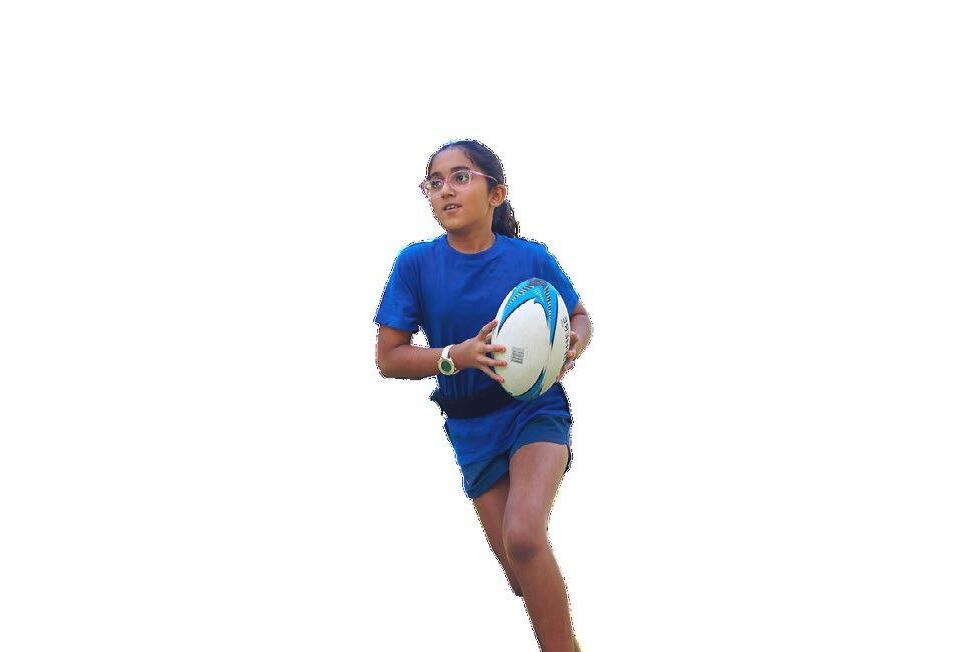

Are you looking for a career change and are passionate about sports and fitness?
EXCITING NEWS
The flagship Bayside GeckoSports franchise business is for sale... Join the FUN!
With over 15 years of proven success working with school aged kids, enjoy owning a business with consistent & multiple income streams, guaranteed programs and a large database to build off.
17 national sports

Fun fitness
Themed programs
Proven systems
School funded programs
Business support
Operate all year
FOR MORE INFOMATION CONTACT:
info@geckosports.com.au
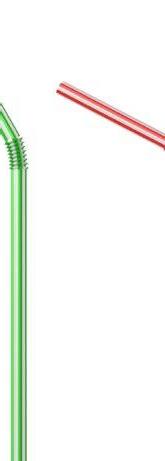
0417 159 807
CYCLE TO SCHOOL

Cancer Council is calling for increased support for younger Australians to walk or cycle to school, with new data revealing a decrease in the proportion of 12 – 17 year-olds using an active mode of transport to get to school each day.
Cancer Council’s National Secondary Students’ Diet and Activity (NaSSDA) study surveyed teens on their diet and lifestyle habits. The survey found students were 29% less likely to actively travel every weekday in 2018 compared to 2009 – 10, with less than one in three Australian secondary students actively travelling to school each day.
Clare Hughes, Chair of Cancer Council’s Nutrition, Alcohol and Physical Activity Committee explained that physical activity in the teenage years is important as it sets up good habits for adulthood.
“Active school travel is an important source of regular physical activity for secondary students. Behaviours established in adolescence create lifelong patterns that promote good health. We want to encourage teens to be as active as possible to achieve the recommended 60 minutes of moderate to vigorous physical activity each day, and the school commute is a great way to fit in more physical activity.”
Physical activity reduces excess weight gain, which is a risk factor for developing 13 different types of cancer later in life. Being physically active can also reduce the risk of endometrial, breast and bowel cancer.
Overall, male students were more likely to actively travel than females. Yet the decline in active travel over time was greater for males, with males 31% less likely to use active travel every weekday in 2018 than in 2009-10 (compared to females being 25% less likely).
Safety concerns appeared to be a key barrier to active travel, especially among female students who were 21% more likely to actively travel if they felt safe walking or riding their bike in their neighbourhood during the day.
The National Obesity Strategy identifies connected spaces such as cycle paths and walkways as important ways to support Aussies to be active within their communities. We urge all Australian governments to act on these recommendations to minimise barriers to physical activity and develop strategies for safer, more accessible environments that support active transport.
Few (1 in 6) teens are currently meeting the recommended health guidelines of 60 minutes or more of moderate-to-vigorous intensity physical activity every day.
We are encouraging Australian secondary students and their parents to look for opportunities to add active travel into journeys to school. This means walking, cycling, scooting or taking public transport, even part of the way. By increasing their daily physical activity levels, teenagers not only benefit their current health but can ultimately reduce their risk of health problems, including cancer, later in life.
42
5 expert tips to boost your teen’s daily active travelling
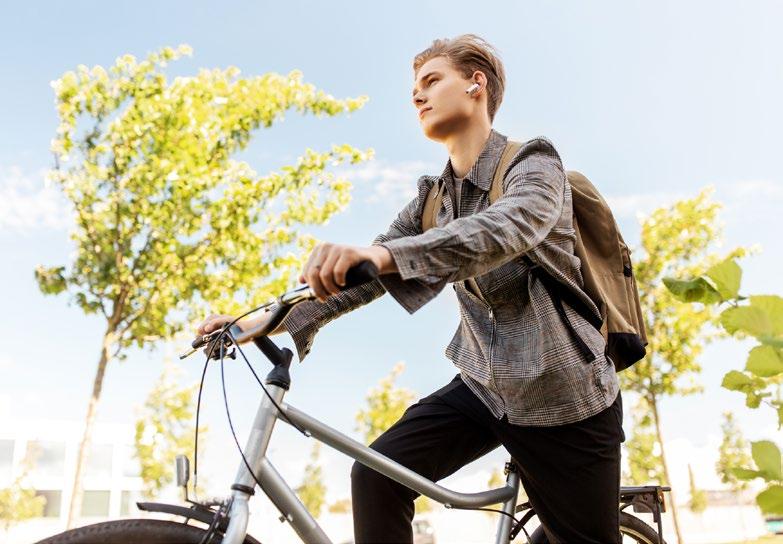
1. Start small
If active travelling to school for the whole journey isn’t an option, try adding walking, cycling, scooting, or taking public transport for even part of the way.
2. Lead (or cycle!) by example
Show your kids how easy it can be to travel through an active mode of transport by riding to errands or the office. Why not consider swapping the morning drop off on some days for a cycle instead to boost your own physical activity levels and make it a family affair?
3. Don’t aim for all or nothing
Be realistic about your child’s schedule and your own commitments. Choosing to walk or cycle to school for even a few days a week can boost your overall physical activity rates.
4. Put it on the calendar
Start by picking a day to try an active school commute, plan it around other activities and set the alarm a little bit earlier if you need to. Simplify your route by mapping it out ahead of time.
About the report
5. Make it socialEncourage your kids to tee up with others in the neighbourhood or friends from school to make travelling in the mornings or after school fun.
‘Trends and determinants of active school travel among Australian secondary school students: national cross-sectional data from 2009 to 2018’ was developed by Cancer Council. The data from the paper, published in the Australian and New Zealand Journal of Public Health this month, was obtained from the National Secondary Students’ Diet and Activity survey. Over a nine-year period, three surveys around diet and lifestyle habits were conducted. Nationally representative samples of Australian secondary school students in year levels 8 to 11 (ages 12 to 17 years) were surveyed in 2009-10 (n=13,790 from 238 schools), 2012-13 (n=10,309 from 196 schools) and 2018 (n=9,102 from 104 schools) using a self-report webbased questionnaire. A total sample of 33, 201 secondary students was achieved.
43
new on the shelf
The Berenstain Bears School Days Collection by Mike Berenstain
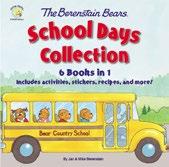
Head back to school with the Berenstain Bears! Young readers will enjoy the stories, activities, stickers, and recipes in The Berenstain Bears School Days Collection, an addition to the Living Lights™ series of The Berenstain Bears books. With stories about starting school, new students, rumors and gossip, and settling disagreements, this treasury is perfect for children beginning a new school year or right in the middle of one.
Published by HarperCollins. RRP $29.99.
Queen Elizabeth II: A Little Golden Book Biography by Jen Arena

Help your little one dream big with a Little Golden Book biography about Queen Elizabeth II! The perfect introduction to nonfiction for preschoolers!
This Little Golden Book about Queen Elizabeth II who sat on the throne for more than 70 years and was the longest ruling monarch of the United Kingdom is an inspiring read-aloud for young girls and boys.
Published by Golden Books. RRP $4.99.
My epic Dad! takes us camping by Dani Vee

This dad will leave you (and himself) in stitches! Things don’t always go to plan when this dad is around, but one thing is for sure – Every adventure turns out EPIC in the end!
Despite the best of intentions, this dad seems to have the worst luck! But… with the right attitude and fully stocked first aid kit, things always have a way of working out in the end. This story will have readers laughing at every page turn and parents will relate to the adventures this epic dad plans, determined to get his kids out in the world and trying new things. As often happens in life, the times when everything goes wrong can create the BEST STORIES!.
Published by Larrikin House. RRP $19.99.
Pocket Treasure by Juliana Oakley and Wenda Shurety

A celebration of sharing, generosity, and all the ‘treasures’ that pre-schoolers like to collect! Allira ‘s favourite dress has pockets that are perfect for holding all her little treasures. There’s something in there for everyone! But when Allira needs to decorate her teacher’s birthday surprise, she finds her pockets are empty! Allira might have given all her treasures away, but she has good friends who can come to the rescue.
Published by Affirm Kids. RRP $19.99.
44
kids
MapMaker by Lisa Moore Ramée
When Walt and his family relocate to Blackbird Bay, Walt thinks it’s the most boring place on earth. While his twin sister, Van, likes to spend her time skateboarding, Walt prefers to hide out in his room and work on his beloved map world, Djaruba. But shortly after their arrival, Walt discovers something extraordinary: He has the ability to make maps come to life.
Published by HarperCollins US. RRP $34.99.
The Lorikeet Tree by Paul Jennings

Since the publication of Unreal! in 1985, readers all around the world have gravitated towards Paul’s children’s books. In The Lorikeet Tree a sister and brother face the hardest year of their lives and discover the healing power of nature. Emily loves the bush and the native animals on her family’s reforested property, particularly the beautiful rainbow lorikeets that nest in one of the tallest trees. But then her father is diagnosed with a terminal illness, and Emily’s world enters a tailspin.
Published by Allen and Unwin Children. RRP $19.99. Ages 11-14.
Solve Your Own Mystery: The Time Thief by Gareth P. Jones
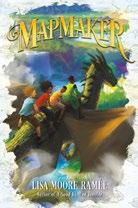

Welcome to Haventry, a town where the ordinary and extraordinary collide! With ghosts, werewolves and zombies living side by side, trouble is always brewing. And when a fiendish crime is committed, YOU are the detective in charge of the case.
The Museum of Magical Objects and Precious Stones is putting on a special time-travelling showcase, but when the main exhibit is stolen, it’s up to YOU to find the thief. The Time Sponge has the ability to stop and start time for whoever squeezes it, so who has the strongest motive?
Published by Walker Books. RRP $16.99.
The Bookshop at the Back of Beyond by Amy Sparkes

Nine and her friends have cured the house’s hiccups and are off to the strange and utterly unpredictable Back of Beyond in search of Professor Dish – Spoon’s best friend and partner in all things alchemy.
When they find Dish trapped by the greedy witch Ophidia in the basement of a particularly marvellous shop, it soon becomes clear they’re going to need something more than Flabberghast’s dicey magic and Nine’s quick thinking to triumph this time. What they really need is a rather clever witch – one particularly good at curses…
Published by Walker Books. RRP $14.99
45
t(w)een
The book of burnout by Bev Aisbett

After two years of the pandemic and lockdowns, working from home, homeschooling, widespread stress and being on our computers and devices 24/7 and constantly available, the danger of burnout for so many of us is all too real. It can happen to anyone.
Australia's bestselling anxiety and mental health expert, Bev Aisbett, tackles a growing mental health emergency: burnout, using humour, straightforward language and her signature illustrations, Bev clearly explains what burnout is, who is at risk, how to recognise the danger signs and, finally, how to step back from the brink, providing insight and techniques to ease burnout and stop yourself going up in smoke.
Published by HarperCollins. RRP $22.99
Menopausing - The Positive Roadmap to Your Second Spring by Davina McCall with Dr Naomi Potter
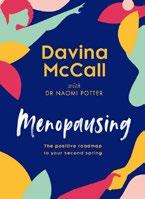
For too long, women have had to keep quiet about the menopause – its onset, its symptoms, its treatments – and what it means for us. Menopausing will build an empowered, supportive community to break this terrible silence once and for all. By exploring and explaining the science, debunking myths, and smashing the taboos around the perimenopause and menopause, this book will equip women to make the most informed decisions about their health… and their lives.
Published by HarperCollins HQ Non Fiction GB. RRP $39.99.
I am enough by Sheridan Stewart
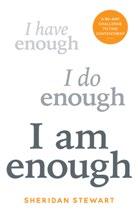
What began as a 90 Day challenge simply to spend less, becomes an exploration of what matters most. I AM ENOUGH contemplates what it means to have enough, do enough and ultimately be enough. Told with insight and humour I AM ENOUGH is an antidote to the constant pressure we are under to do more, have more and be more. Split into three parts, this is a timely and useful 90-day program that teaches readers to look beyond the overwhelming pressures to have, be or do more.
Published by Aurum Press RRP $29.99
You Take Care by Laura Henshaw and Steph Claire Smith

Best friends and creators of the massive health and lifestyle brand Keep It Cleaner, You Take Care Laura and Steph's way of sharing everything they've learnt about taking care of their mental health, bodies, and relationships with those around them, including thoughts on motherhood and a search for progress over perfection. thoughts on motherhood and a search for progress over perfection. No two journeys are the same, and there will always be bumps along the way. But thisuplifting and friendly guide is like having a best friend in your pocket, cheering you on through it all.
Published by Murdoch Books. RRP $36.99.
46
adults





Get more from mama - www.mamamag.com.au | Get social with mama - @localmamamag 47 FREE ENTRY LABOUR DAY LONG WEEKEND
SCREAM TIME
Are you screaming for the kids to get off their screens? Australians spend almost 17 years in their lifetime staring at a screen. Globally, people average almost seven hours of screen time per day - that's roughly 40 percent of their total waking hours. The inaugural ‘Great Australian Switch Off’ took place on Sunday 4 December, with people across the country encouraged to embark on a ‘digital detox’ by switching off their screens for 24 hours.
Dr Sarah Hanieh (MBBS, FRACP, PhD), creator of The Great Australian Switch-Off, came up with the idea to start an important conversation about the harmful effects of excessive screen time in today's society and to raise awareness about how screen time may displace other important moments and opportunities in a child’s life.
And it’s not too late to incorporate The Great Australian Switch Off’s principles into our daily lives on a regular basis. There are many ways we can keep things entertaining and fun over the summer break by minimising our screen use and making the most of downtime with loved ones.
Track your daily screen time
When we are casually scrolling through Facebook, TikTok and Instagram it's not hard to become fixated on your screen. A good way to keep track of your daily scrolling habits
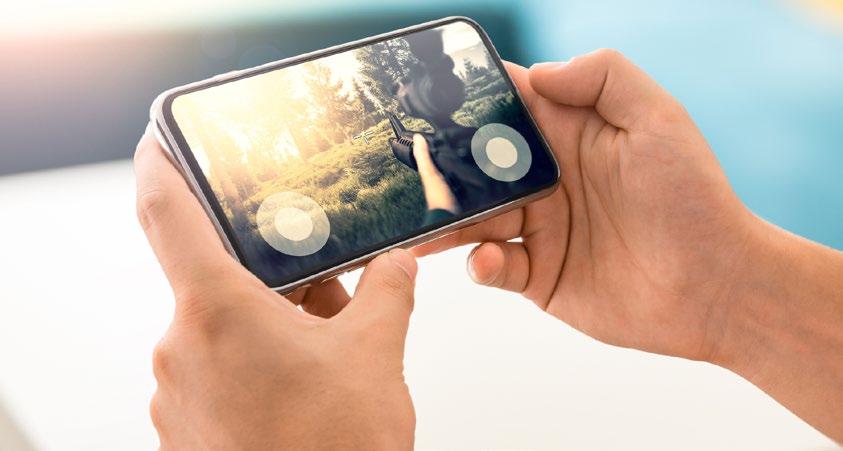
is to identify how much screen time you are actually getting each day, and then create a family screen time plan together that outlines how each family member will use their screens. It’s really important to have a whole family discussion and ensure that everyone understands the rationale behind creating boundaries around screen time.
Once you've established a screen time limit that's suitable to your lifestyle, sit down with your children every week and talk together about how they plan to use it. This can help create that perfect screen time to family time ratio, and also create a sense of autonomy and control over screen time decisions.
Switch off while you’re with family and friends
Family relationships are an important part of a child’s development. Children look to their caregivers and the connection they have to others to gain a sense of belonging. Excessive screen time can damage the opportunity for children to develop the crucial connections and personal interaction skills they need.
When parents are engaging with a screen, children may feel the need to compete for attention. So, by setting down your device, children will feel their parents are more emotionally available. This small step can help strengthen your family bond.
48
Screens down during meals
According to The National Library Of Medicine, there is evidence that eating meals while watching TV is an obesogenic factor. This may be as a result of decreased physical activity and more sedentary behaviour, increased exposure to junk food advertisements, as well as interruptions to sleep patterns. Moreover, the association between media exposure and childhood obesity has been supported by research over the past several decades, with the pattern of screen use during meals beginning early and persisting through to adulthood.
Having the television (or other screens) on during meal times is never a good idea. Once this becomes a pattern, it can be hard to reverse. A great way to break the habit is by choosing one meal where you will switch off all devices. Once you start weaning your child off screens, don’t stop there. Every two to three days you can choose another meal to go screen-free until eventually the screen meals stop all together. A simple ‘no devices allowed at the table’ rule can surprisingly bring your family closer together during dinner time.
Get active
Children are naturally curious and long for the outdoors. Instead of spending time glzued to your devices, encourage yourself and your family to try new outdoor activities, especially over the Christmas break. Go for a bike ride or walk, visit a park, have a beach day or explore a local nature trail. Playing and being outdoors is so important for a child’s physical and cognitive development, as well as their social and emotional well-being.
It is widely known that screen time contributes to negative physical health effects including increased obesity, lack of physical activity and poor posture. So switch off your devices to switch on to the outside world and all it has to offer.
Remove social media apps from your device
While social media can be a great way to connect and communicate, there is a fine line between us being in control of our social media use, and social media being in control
of us. It’s no secret that these platforms have worked out specifically how to keep us coming back for more. They know how to keep us checking and scrolling, and because this works on a deeper psychological and neurochemical level, it can be difficult to fight the compulsion loop that has been created to keep us checking and scrolling.
The key is to be aware of how they work, and to limit their use where possible. Delete any toxic apps from yours or your child’s phone, particularly those that add nothing to your life, but only create anxiety, division, or low self-esteem.
A 2021 study by ‘Cyberpsychology, Behavior, and Social Networking’ involving 132 people found that limiting social media use for a week improved well-being by preventing sleep problems. However, the authors note that adolescents who were already heavily engaged with social media may have chosen not to participate in the study because they were unwilling to reduce their use.
By blocking access to your social media apps at a specific time, such as before bed, or even removing apps for a dedicated day of the week, you may notice increased sleep, more quality family time, and even a reduction in anxiety and depression.
Look for other ways to get that dopamine hit that you might be getting from social media. There are so many other ways to create a natural dopamine surge in your brain, such as being outdoors in nature, exercising, listening to your favourite music, challenging yourself to do something completely different or new for the first time, and achieving a goal.
Finally, consider signing up to ‘The Social Deedia Project’. This new initiative by Dr Hanieh is asking whether you could give up social media for ‘good’? “We are creating a platform where we are asking you to swap out a portion of the time you spend on social media every week, to instead do something ‘good’ for someone else.”
Learn more about The Social Deedia Project here: https://thegreataustralianswitchoff.com/ the-social-deedia-project/
49
FROM NAPPIES TO NUTRIENTS...

Aussie parents are one step closer to being able to recycle disposable nappies, thanks to an industry-leading nappy recycling pilot program from Huggies® parent company, Kimberly-Clark.
There are approximately 300,000 babies born in Australia every year and approximately 95% of them wear disposable nappies. The Nappy Loop recycling program, which is the first of its kind in Australia, aims to provide a sustainable solution for the 1.5 billion disposable nappies that end up in landfill each year.
Launched as a trial in South Australia, The Nappy Loop recycling program is a partnership with Australia’s national science agency CSIRO, one of South Australia’s largest composters, Peats Soils and Garden Supplies, early learning and care provider G8 Education and Solo Resource Recovery. The program sees used nappies collected from the daycare centre and delivered to a composting facility for processing. CSIRO is providing scientific validation of the pilot program, which will help inform the team on the potential scaling of the program.
The recycling program uses a process known as anaerobic digestion to turn used Huggies nappies into nutrient-rich compost, and the plastic components are separated and evaluated for future recycled products. Meanwhile, bioenergy that is captured from the process is used to power the composting facility. To understand more about the nappy recycling process, visit www.huggies.com.au/ nappy-recycling.
CSIRO’s Principal Research Scientist Dr Anu Kumar said: “CSIRO is working with Kimberly-Clark Australia to provide scientific validation of The Nappy Loop pilot to help tackle waste. Our research for this Australian trial will help inform the team on the potential scaling of the program to help reduce the amount of nappies ending up in landfill.”
Kimberly-Clark’s ANZ Managing Director, Belinda Driscoll added: “Families and day care centres across the country rely on the convenience and performance of disposable nappies, and while we work to innovate and create more sustainable products, recycling is the best answer to the disposable nappy waste issue today. At Huggies, improving our sustainability has been a longstanding priority for us and we’re proud to be leading this Australian-first nappy recycling program here in Australia, offering parents a solution to sustainable disposable nappy use”.
G8 Education, Ali Evans, Head of Learning commented on the initiative: “Through this partnership the nappies changed every day at our Welly Road centre are recycled instead of going into landfill. As educators of our future generations, sustainability is a core focus in all our 440 centres across Australia and we’re excited to contribute to this partnership and the positive environmental impact it can make.”
After five months of recycling used nappies, The Nappy Loop team is now exploring the opportunity to scale the program in South Australia and nationally. This includes partnering with APR Plastics to test the recycling of the recovered plastic from the nappies using pyrolysis, with the aim of having results available in early 2023. So keep your eyes peeled for more exciting news!
50
This industry-first nappy recycling pilot program could be Australia’s answer to the 1.5 billion disposable nappies that end up in landfill each year.
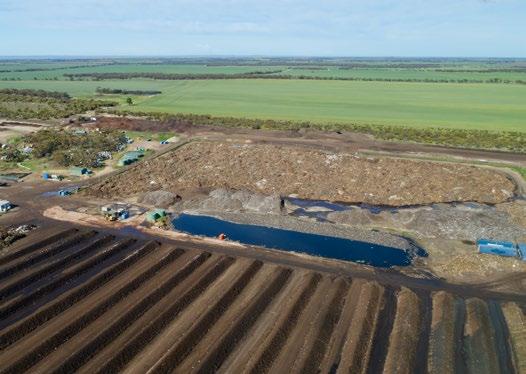

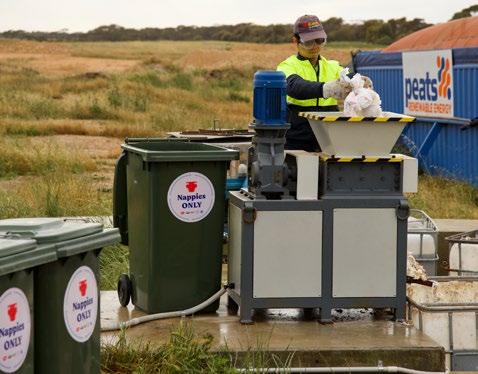
51
PLAYGROUND SQUEEZE
As school enrolments climb and urban spaces become more crowded, some Australian schools have been left with less play space per student than a prison cell.
Standard prison cell guidelines recommend at least 7.5 square metres per prisoner. One Sydney school reportedly has just 1.14 square metres of play space per student.
As experts in health and physical education, we are deeply concerned by reports students are running out of play space.
Why is this a problem? And what options do parents and teachers have to keep young people happy and healthy?
Space at a premium
Australian student numbers are predicated to increase by 17% over the decade to 2026, creating a need for hundreds of new, mostly metropolitan schools and new classrooms in areas previously set aside for play.
With only small blocks available for some inner-city school sites, “vertical” schools have
been established in most Australian states. More vertical schools are planned, even at the primary level.
Vertical schools can provide some space for climbing, indoor running and ball sports, as well as outdoor areas such as rooftops.
But a lack of space and a reliance on lifts rather than stairs does not help keep kids active or provide much opportunity to engage with nature.
Australian kids have alarmingly low physical activity levels. Making sure students get the activity they need is vital for them to grow up fit and healthy.
How much space do kids need?
Australian guidelines on free play space –school areas other than buildings, footpaths and car parks – suggest a minimum of ten square metres per student.
However, Australian researchers have recommended school spaces should ideally be increased to 25 square metres per student,
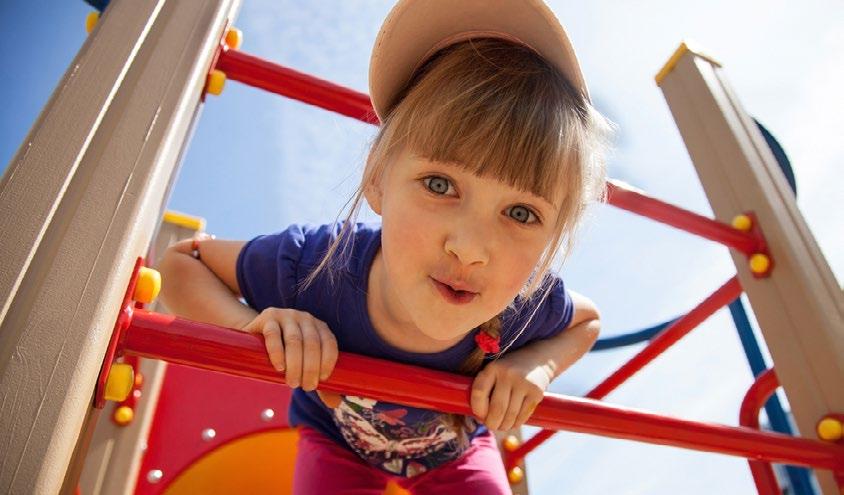
combined with access to portable play equipment such as balls, bats and blocks. Even more space can have extra benefits. Two studies in Europe showed when more than 15 square metres per student was available, primary school children were much more physically active than those with less than eight square metres.
A study in the United Kingdom found that as play spaces per child increased, so did more vigorous physical activity. Smaller play spaces can result in crowded play, clashes and reduced movement.
8 ways to keep kids active in small spaces
Children need space to discover, take calculated movement risks and extend themselves physically. Here are eight ideas to keep young people active in confined spaces. These can be adapted to the home, classrooms, gymnasiums and outdoor areas, whatever the weather.
1. Move to a theme
Give kids a body movement theme, such as “stand as tall or as wide was possible”.
Students then move in a variety of ways to match the theme – widening or narrowing their body, twisting, turning, bending, stretching, balancing, rolling and transferring body weight.
2. Use activity ‘zones’
Use task cards to create zones and stations in small spaces where small groups of students can do different activities such as push-ups or skipping. Cards can illustrate ways to undertake the activities at different levels –from easy to medium and difficult.
Sport Australia’s Playing for Life cards allow teachers and parents to match activities to children’s ages.
3. Move to music
Dance offers a wide variety of activities and sequences of movements that can be done in a small space.
Along with making up their own dances, students can perform movements that suggest words for others to guess. Another option is regular one-minute bursts of movement with music throughout the day.
4. Set up obstacle courses
Get students to make up obstacle courses. Not only is this an exercise in problem-solving, it can also increase their motivation around physical education.
5. Use nearby parks and facilities
Many young people do not use their closest park. But public spaces can be a valuable resource for physical education and engagement with the community.
6. Play co-operative games
Develop co-operative movement challenges. These ask groups to work together in a small space, developing not just gross motor skills, but team work and problem-solving. An example is throwing a scarf in the air that both partners need to catch, gradually increasing the distance apart.
7. Adapt the space
Use colours, lines and patterns within spaces as guides for students to follow, aim towards and jump on during movement activities.
It’s also a useful way to break up the space into zones for different activities, and even target games such as bowling and beanbag bocce.
8. Look beyond PE
Beyond physical education school subjects
there are other opportunities to be active. This even includes traditional subjects like maths and English, which can be adapted to use movement-based activities.
By Brendon Hyndman, Associate Dean (Research) and Associate Professor of Education (Personal Development, Health & Physical Education), Charles Sturt University; Jessica Amy Sears, Lecturer,
Charles Sturt
University
and Vaughan
Cruickshank, Program
Director – Health and Physical Education, Maths/ Science, Faculty of Education, University of Tasmania. This article is republished from The Conversation under a Creative Commons license. Read the original article
53
SELECTIVE SCHOOLS
Selecting a secondary school for your child can seem overwhelming. There are so many decisions to make as you consider all the possibilities. Do you want a Catholic, government or private school? Single-sex or co-educational? These decisions can seem overwhelming for families when trying to ensure their child gret the best education suited to them. And what about a selective entry school for the more academic student?
What is selective school?
Selective schools are public high schools where students sit a competitive test to be accepted the year before entry.
They are mostly found in New South Wales, where there are about 50 schools. But there are small number in other states, including Queensland (years 7 to 12), Victoria (years 9 to 12) and Western Australia (7 to 12).
The success rate varies, but is is very competitive. For example, in NSW this. year, there were 15,660 applications for 4,248 places.
The pros and cons
Selective school places are highly sought-after – these schools feature prominently in the top schools for year 12 results. But they don’t have the fees of elite private schools.
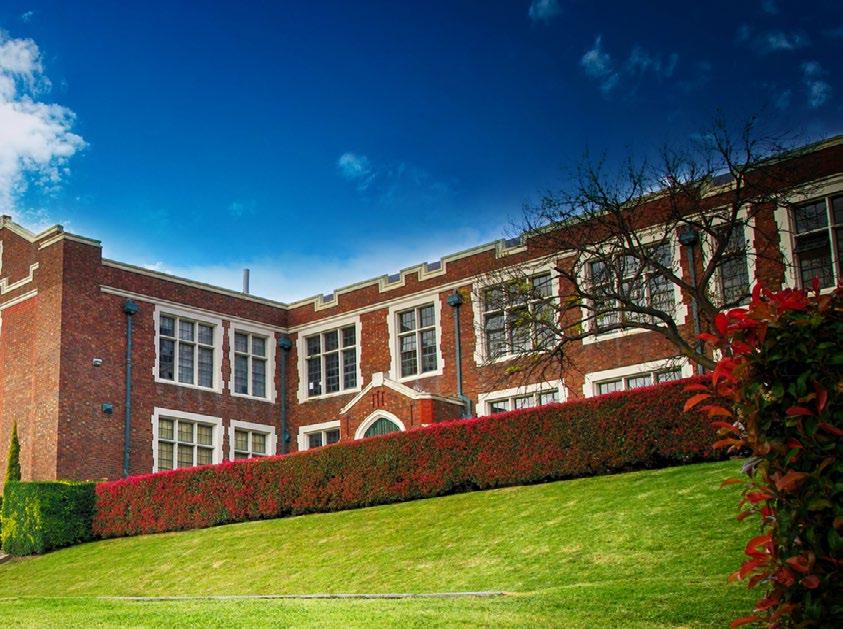
Some students feel energised by the “best of the best” atmosphere in which they can focus and find similarly capable peers.
But there is an ongoing debate about whether they should exist in the first place. There is also an obvious focus on test performance, rather than the modern skills students need to learn such as collaboration, tech literacy and creativity.
And while academic streaming does seem to improve the performance of high achievers, it can harm the confidence of those who get in (as well as those who don’t).
As Australian Catholic University education scholar Associate Professor Philip Parker has explained, selective schools can create a “big fish little pond” effect where students lose a
54
realistic sense of where they fall within the full student achievement spectrum.
Even if students gain a place at selective school, they can find the competition counter-productive. Australian selective school students are increasingly speaking out about the mental health impacts of studying in a stressful, competitive environment.
Don’t forget tutoring
The Australian tutoring industry is huge, not just for parents seeking to improve their child’s performance in class, but in preparation for selective entry exams.
While the entry tests measure general literacy, maths and logic skills – and do not require study – many students undergo months or even years of expensive and often stressful tutoring to prepare.
A 2010 US study suggested tutoring and coaching for selective entry exams only had a moderate effect on student’s results, but this is far from conclusive. Given the competition to gain entry to these schools, students and their parents may be more confident knowing they’ve had tutoring. That confidence alone may improve their performance.
Victoria has four select entry schools:
Melbourne High School (boys only) in South Yarra.
The Mac.Robertson Girls' High School (girls only) in Melbourne.
Nossal High School (all genders) in Berwick.
Suzanne Cory High School (all genders) in Werribee.
Victorian select entry schools begin in year 9 and applications for 2024 open soon and the examination is scheduled for mid-2023.
Find out more at https://www. vic.gov.au/selective-entry-highschools#applying-for-year-9-entryin-2024
What should parents think about?
It’s understandable that parents might be confused. How do you know if the selective school is right for your child? Here are some issues to consider:
School culture
are the schools you are considering particularly competitive? Do they have an emphasis on other activities, away from exam marks? Do they encourage sport, music or creative arts? Do they emphasise mental health? Do they have programs to support students from diverse backgrounds and with diverse identities?
Location
If your child is successful, will it mean a very long commute for them?
Your child’s strengths
Does your child enjoy school work and sitting tests? Or do their strengths lie in other, less traditionally academic areas?
Your child’s temperament
Does your child become anxious in testing situations, or do they enjoy the “performance” aspect of them?
Your child’s opinion
Is your child self-motivated to go to a selective school, or are you trying to convince them it’s “good” for them? If they are keen, giving them a chance - with the appropriate supportmight help them decide.
Tutoring
Does your child want to do tutoring or exam preparation? Can you afford the fees and time if they do?
Your child’s teacher
Have you had conversations with your child’s teachers? Do they believe your child has the academic aptitude and emotional capacity
By Daniel X. Harris, Professor and Associate Dean, Research & Innovation, RMIT University
This article is republished from The Conversation under a Creative Commons license. Read the original article
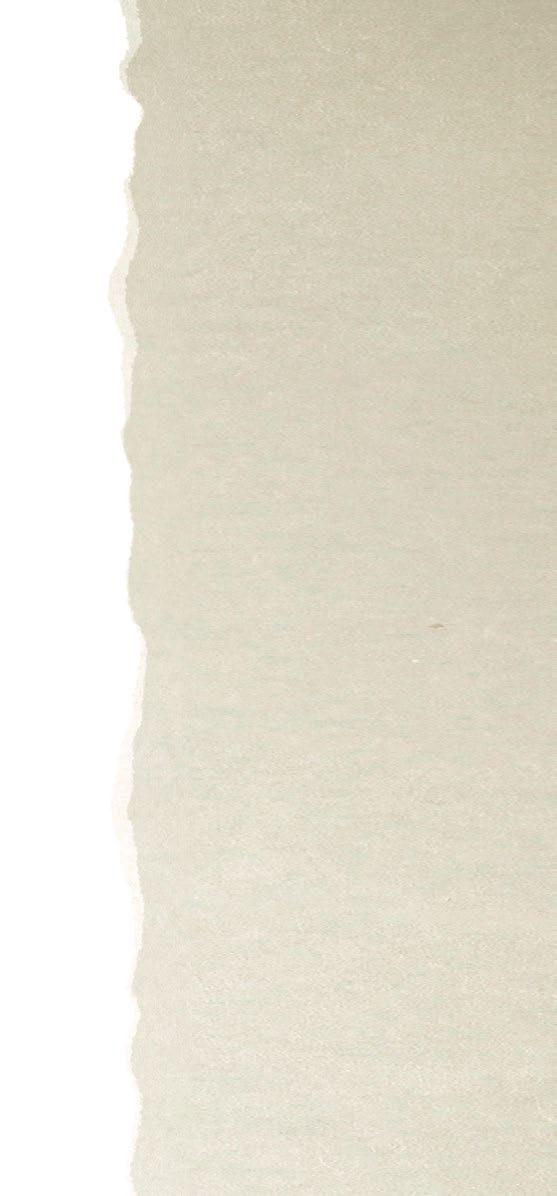
55
Single-use plastics ban
From 1 February 2023 these single-use plastics are banned in Victoria
Some exemptions apply to specific items.

* People who need single-use plastic straws due to a disability or for a medical need can still buy and use them.
www.vic.gov.au/ plastics
Single-use plastic straws & stirrers
Single-use plastic cutlery
Single-use plastic plates
Expanded polystyrene foodware & cups
Single-use plastic cotton buds





















































































































